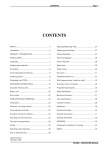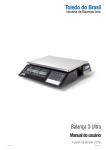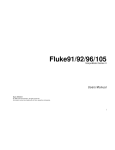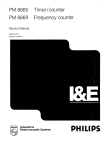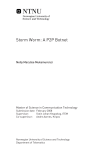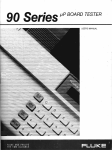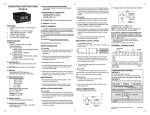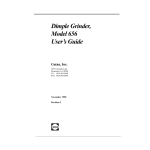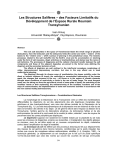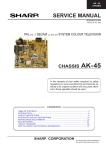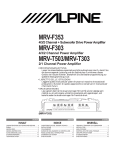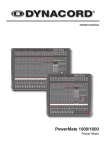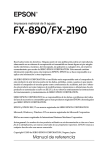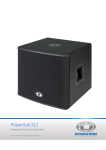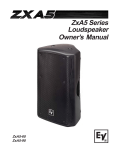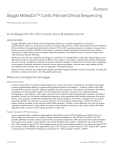Download Fluke Universal Frequency Counter PM6669 Operator`s Manual
Transcript
Universal Frequency Counter PM6669 Operators Manual CONTENTS Page: 1 CONTENTS SAFETY ........................................................................... 2 Introduction ................................................................... 2 PRODUCT PRESENTATION ......................................... 3 General ......................................................................... 3 Rear View...................................................................... 3 Front View ..................................................................... 4 INSTALLATION ............................................................... 5 Unpacking ..................................................................... 5 Voltage-Range Selection .............................................. 5 Grounding ..................................................................... 5 Connecting External Reference.................................... 6 Installing Options .......................................................... 6 Calibrating the MTCXO................................................. 6 OPERATING INSTRUCTIONS........................................ 8 Using the Frequency Counter....................................... 8 Battery Unit ................................................................20 Error Codes.................................................................20 GPIB-INTERFACE OPERATION .................................. 21 Introduction .................................................................21 What Can I Do Using the Bus?...................................21 Connecting the Controller ...........................................22 Giving the Counter an Address...................................22 Checking the Communication.....................................22 Two Ways of Programming.........................................23 Syntax .........................................................................23 Selecting Output Separator.........................................24 How to Select Function ...............................................24 Selecting Measuring-Time...........................................24 Selecting Triggering.....................................................25 Totalize Start/Stop .......................................................25 Free-Run/Triggered .....................................................25 Service Request ..........................................................26 Status Byte ..................................................................26 Output Mode................................................................27 Bus Learn ....................................................................30 Programming Data Out ...............................................30 What Happens When I Switch to Local?.....................30 Summary of Bus Commands ......................................31 Programming Examples..............................................32 SPECIFICATIONS .........................................................35 Measuring Functions ...................................................35 Definitions....................................................................36 Input specifications......................................................36 General Information.....................................................37 Auxiliary Functions ......................................................38 Optional Accessories...................................................38 Ordering Information ..................................................40 APPENDIX 1 ..................................................................41 Checking the Sensitivity of Counters ..........................41 INDEX ............................................................................43 4822 872 20021 5/12-April-1995 PM 6669 - OPERATORS MANUAL Page: 2 SAFETY SAFETY Introduction Read this page carefully before you install and use the PM 6669 Frequency Counter. CAUTION: Indicates where incorrect operating procedures can cause damage to, or destruction of, equipment or other property. This Frequency Counter has been designed and tested in accordance with IEC publication 1010-1, and CSA 22.2 No.231, and has been supplied in a safe condition. The user of this instrument must have the required knowledge of PM 6669. This knowledge can be gained by thoroughly studying this manual. WARNING: Indicates a potential danger that requires correct procedures or practices in order to prevent personal injury. Symbols Safety Precautions Use generally-accepted safety procedures, in addition to the safety precautions stated in this manual, to ensure personal safety and safe operation of the Frequency Counter. Caution & Warning Statements You will find specific warning and caution statements, where necessary throughout the manual. Do not carry out repairs or adjustments to the Frequency Counter without reading the Service Manual, which contains the relevant warnings for such activities. Indicates where the protective ground lead is connected inside the instrument. Never unscrew or loosen this screw. If in doubt about safety Whenever you suspect that it is unsafe to use the instrument, you must make it inoperative, clearly mark it to prevent its further operation, and inform the Fluke service Centre. E.g.The instrument is likely to be unsafe if it is visibly damaged. PM 6669 - OPERATORS MANUAL PRODUCT PRESENTATION Page: 3 PRODUCT PRESENTATION General Rear View The PM 6669 is a compact, high resolution, reciprocal Frequency Counter which performs many functions. A number of options are available i.e. HF-input, GPIB-interface, high stability oscillator, and rechargeable battery for field use. A) Rear feet. B) Screws for removing the cover. C) External-reference-input, BNC connector. D) Voltage-range selector. A rack-mount kit and a carrying case are also available as accessories. E) Power-inlet socket. F) GPIB interface-connector (optional). G) GPIB address-selector ( option). F G IEEE 488 INTERFACE TALK ONLY ADDRESS 16 8 4 2 1 ON SUPPORTED FUNCTIONS: SH1,AH1 T5,L4 SR1,RL1 DC1,DT1 E2 OFF INCLUDED OPTIONS PM 9604 PM 9605 PM 9607 EXT REF INPUT VOLTAGE SELECTOR PM 9608B 10MHz 0.5-15Vrms THERMAL FUSE IN MAINS TRANSFORMER A Figure 1 B C D E B A Rear View. PM 6669 - OPERATORS MANUAL Page: 4 PRODUCT PRESENTATION H J K L M PM 6669 UNIVERSAL FREQUENCY COUNTER MEASURING TIME SINGLE 0.2s 1s 10s DISPL HOLD 160MHz/1.3GHz TRIGGER LEVEL A INPUT A AUTO INPUT B FILTER<50kHz OPTION SENSITIVITY FREQ A FREQ B FREQ A/Ao RESET LOCAL ON STANDBY FREQ A-Ao MEAS TIME RPM A FUNCTION PER A TOT A DISPL HOLD WIDTH A BLANK DIGITS EXT REF MIN 10mVrms 200mVrms A TRIGGER LEVEL A 50 Ω 1MΩ 30pF TOTALIZE A START/STOP N Figure 2 O P STORE Ao R S MAX 350Vp T 70MHz - 1.3GHz 10Hz-160MHz MAX 12Vrms U V Front View. Front View P) Measuring-time selector-button. * R) Function-selector button. * S) Display-hold button. Freezes the display. The button is also used for storing A0. T) Blank digits button. Blanks out one digit for each depression of the button, from the right to the left of the display. (No rounding off). H) Large LCD-display. J) Input-A BNC-connector. K) Sensitivity control with dual-range push-in/pull-out switch. L) 50 kHz filter switch (Input-A). M) Input-B BNC-connector (optional). U) Trigger level setting button. N) Power switch. V) Tilting support. O) Reset button, doubles as Local button if the Frequency Counter is equipped with an GPIB interface. Starts and stops counting if the TOT A function is selected. * The selected function is indicated on the display. A short press on the button moves the cursor one step to the right. A long press makes the cursor scroll. PM 6669 - OPERATORS MANUAL INSTALLATION Page: 5 INSTALLATION Unpacking Voltage-Range Selection If the Frequency Counter is cold, leave it in the cardboard box until it has reached normal room temperature. Set the Frequency Counter to the local line voltage before connecting it. As delivered the Frequency Counter may be set to either 115 V or 230 V. The setting is indicated on the voltage range selector on the rear panel. – – – – Lift the Frequency Counter out of the box. Remove the polystyrene supports. Unpack the Frequency Counter from the plastic bag. Reverse the procedure to pack. IEEE 488 INTERFACE TALK ONLY ADDRESS 16 8 4 2 1 ON Check List SUPPORTED FUNCTIONS: SH1,AH1 T5,L4 SR1,RL1 DC1,DT1 E2 OFF INCLUDED OPTIONS PM 9604 PM 9605 PM 9607 Has the Frequency Counter been damaged in transport? If it has, file a claim with the carrier immediately, and notify the Fluke sales & service organization to make repair or replacement of the instrument easier. EXT REF INPUT PM 9608B VOLTAGE SELECTOR 10MHz 0.5-15Vrms THERMAL FUSE IN MAINS TRANSFORMER – Check that the package contains the following items in addition to the Frequency Counter: – – – – – – *) This Operators’ Manual A power cable with protective earth conductor A Battery unit if ordered *) An MTCXO oscillator if ordered *) Figure 4 Location of Voltage Range Selector. A GPIB interface if ordered *) An HF-input if ordered *) Labels on the rear panel indicate which options are fitted in your Frequency Counter. If the voltage range setting is incorrect, set the selector in accordance with the local voltage before connecting the power cable to the line. INCLUDED OPTIONS PM 9604 PM 9605 PM 9607 Figure 3 PM 9608B Options Label on Rear Panel. Grounding The Frequency Counter is connected to ground via a sealed three-core power cable, which must be plugged into a socket outlet with a protective ground terminal. No other grounding is permitted for this Frequency Counter. Extension cables must always have a protective ground conductor. PM 6669 - OPERATORS MANUAL Page: 6 INSTALLATION Removing the Cover WARNING: Never interrupt the protective grounding intentionally. Any interruption of the protective ground connection inside or outside the instrument, or disconnection of the protective ground terminal is likely to make the instrument dangerous. WARNING: When you remove the cover you will expose live parts and accessible terminals which can be dangerous to life. Connecting External Reference If you wish to use an external 10 MHz reference frequency source, connect it via a BNC-cable to the EXT REF INPUT on the rear panel of the Frequency Counter. When the Frequency Counter starts measuring, it automatically detects the external reference and begins to use it. The EXT REF indicator on the display is switched on. Loosen the two screws using a Pozidrive No. 1 screwdriver Installing Options Figure 5 Loosen These Screws to Remove Cover. Introduction The options ordered at the same time as the Frequency Counter are normally factory-installed. Other options can be fitted when needed. The options fit inside the Frequency Counter, but not all at the same time: The HF-input, the high stability-oscillator and either of the GPIB-interface or the Battery-unit can be installed in one and the same Frequency Counter. Calibrating the MTCXO – Make sure that the power cable is disconnected. WARNING: Although the power switch is in the off position, the line voltage is present on the printed circuit board. – Loosen the two screws in the rear feet. – Grip around the front panel and pull the Frequency Counter out of the cover. The MTCXO Time-base can easily be recalibrated to any 10 MHz reference. To maintain the accuracy of the MTCXO, use a reference with an accuracy of 3*10-8. Calibration Procedure The PM 9691 oven-enclosed oscillator used in Fluke counters version /.5. meet this requirement, if calibrated. – Remove the cover from the counter. – Allow the MTCXO to adapt the new ambient tempera- Preparations – Connect the 10 MHz reference to Input-A. – Switch ON the counter. – Adjust the sensitivity control so that the counter counts ture. (See ’Preparations’.) If you remove the cover when counter has been switched on, the temperature of the MTCXO will rapidly drop about 10°C. Since the MTCXO must have a stable temperature when calibrated you must wait an hour between removing the cover and calibrating. If the counter has been switched off more than three hours, you can calibreate it directly. PM 6669 - OPERATORS MANUAL properly. – Hold down the CALIB-button, on the main printed-circuit board in the counter, and press the Reset-button. INSTALLATION Page: 7 – Wait about 20 seconds, until the display shows 10.0000000 MHz. Now the oscillator is calibrated. CALIB-button – Switch OFF the counter and disconnect the 10 MHz reference. Fit the cover. Figure 6 Location of the CALIB-Button. PM 6669 - OPERATORS MANUAL Page: 8 OPERATING INSTRUCTIONS OPERATING INSTRUCTIONS Using the Frequency Counter CONTROL ON STAND-BY OPERATING THE CONTROL POWER, a two-position mechanical push-button. Pressed = ON, Released = OFF DISPLAY GPIB-CODE MEASURING TIME SINGLE 0.2s 1s FREQ A FREQ B FREQ A/A0 MEASURING TIME SINGLE 0.2s 1s 10s FREQ A-A0 10s DISPL HOLD TRIGGER LEVEL A AUTO RPM PER A A FUNCTION DISPL HOLD TOT A WIDTH A No control possible but D gives the same settings as after power-ON. EXT REF TRIGGER LEVEL A AUTO 0. MkHz ums GATE FREQ A FUNCTION FUNCTION FREQ B FREQ A/A0 FREQ A-A0 RPM PER A A FUNCTION TOT A WIDTH A EXT REF One code for each function, - see below: A short depression of the FUNCTION key moves the cursor in the lower edge of the display one step to the right. If the key is held depressed, the cursor will scroll to the right until released. When the cursor reaches the rightmost position it jumps back to the leftmost position and continues from there. Move function cursor to FREQ A MEASURING TIME SINGLE 0.2s 1s 10s DISPL HOLD TRIGGER LEVEL A AUTO 0. kHz FREQ A PM 6669 - OPERATORS MANUAL FREQ B FREQ A/A0 FREQ A-A0 RPM PER A A FUNCTION TOT A WIDTH A EXT REF FREQ A OPERATING INSTRUCTIONS Page: 9 FUNCTION AND RANGE HINTS AND COMMENTS Switches the power ON and OFF. When switched on, the built in microprocessor switches on all segments of the display then it runs a power-up test, checking the measuring-logic of the Frequency Counter before the counter starts working. This test takes about 2 seconds. WARNING:The power switch operates on the secondary side of the transformer. The power cable must be disconnected from the line outlet socket if it is necessary to completely isolate the Frequency Counter from the line. If an error is found, an error code will be displayed. Try switching the Frequency Counter off and on again. If error code 01 - 03 persists, call Fluke service. Look on the last page in this manual for Phone No. and address. Error Error Error Error Selects one of the nine measuring functions available. The cursor does not stop at FREQ C if no Input-C HFinput is installed. Reciprocal frequency measurement of the signal at Input-A. If the signal is sine shaped and the input AC coupled, the minimum input frequency is 20 Hz (at specified sensitivity). 01 = RAM memory error 02 = Measuring logic error 03 = Internal bus error OF = Overflow in the counting registers Range: 0.1 Hz to 16 MHz (SINGLE measuring-time) 1 Hz to 160 MHz (0.2, 1, and 10 s measuring-time) PM 6669 - OPERATORS MANUAL Page: 10 CONTROL FUNCTION OPERATING INSTRUCTIONS OPERATING THE CONTROL Move function cursor to FREQ B DISPLAY GPIB-CODE MEASURING TIME SINGLE 0.2s 1s 10s DISPL HOLD TRIGGER LEVEL A AUTO FREQ B 0. kHz FREQ A FUNCTION Move function cursor to FREQ A/A0 Move function cursor to FREQ A-A0 FREQ B FREQ A/A0 MEASURING TIME SINGLE 0.2s 1s 10s RPM PER A A FUNCTION DISPL HOLD TOT A WIDTH A EXT REF TRIGGER LEVEL A AUTO Not bus selectable FREQ A-A0 10s RPM PER A A FUNCTION DISPL HOLD TOT A WIDTH A EXT REF TRIGGER LEVEL A AUTO Not bus selectable 0. Move function cursor to RPM A FREQ B FREQ A/A0 MEASURING TIME SINGLE 0.2s 1s FREQ A-A0 10s RPM PER A A FUNCTION DISPL HOLD TOT A WIDTH A EXT REF TRIGGER LEVEL A AUTO RPM A 0. FREQ A FUNCTION FREQ A-A0 0. FREQ A FUNCTION FREQ A/A0 MEASURING TIME SINGLE 0.2s 1s FREQ A FUNCTION FREQ B Move function cursor to PER A FREQ B FREQ A/A0 MEASURING TIME SINGLE 0.2s 1s FREQ A-A0 10s RPM PER A A FUNCTION DISPL HOLD TOT A WIDTH A EXT REF TRIGGER LEVEL A AUTO PER A 0. ms FREQ A FUNCTION Move function cursor to TOT A FREQ A/A0 MEASURING TIME SINGLE 0.2s 1s FREQ A-A0 10s RPM PER A A FUNCTION DISPL HOLD TOT A WIDTH A EXT REF TRIGGER LEVEL A AUTO 0. FREQ A PM 6669 - OPERATORS MANUAL FREQ B FREQ B FREQ A/A0 FREQ A-A0 RPM PER A A FUNCTION TOT A WIDTH A EXT REF TOTM A OPERATING INSTRUCTIONS Page: 11 FUNCTION AND RANGE HINTS AND COMMENTS Reciprocal frequency measurement of the signal at Input-B. The cursor does not stop at FREQ B if no Input-B HFinput is installed. Range: 70 to 1300 MHz (PM 9608B) The counter divides the frequency on Input-A by a constant, A0, that is stored in the counter in the following way: 1) Connect a signal with the frequency to be stored as A0 to Input-A. 2) Select FREQ A. 3) Depress the DISPL HOLD key and hold it depressed until the DISPL HOLD indicator is switched off again. Now A0 is stored. 4) Select FREQ A/A0. 5) Connect the frequency to be measured to Input-A. If you select this function without storing A0, Frequency A will be displayed. The counter substracts a constant, A0, from the frequency at Input-A. You can read about how to store A0 in the description for FREQ A/A0. If you select this function without storing A0, Frequency A will be displayed. This function is convenient when an oscillator is to be tuned to the frequency of a reference oscillator. It is much easier to adjust until the display shows 1.0000000 than 7.1223678. This function can e.g. be used in a radio to display the received frequency; Set the intermediate frequency as the constant A0. Select FREQ A-A0 and measure the frequency of the local oscillator, and the display will show the received frequency. The frequency on Input-A is multiplied by 60 and displayed as Revolutions Per Minute. Range: 6 RPM to 720 000 000 RPM. When you select SINGLE, the Frequency Counter measures one period, the range is: 100 ns to 200 000 000 s (about 6 years and four months!). When you select 0.2, 1, and 10 s Measuring-time, the Frequency Counter divides the input frequency by 10 and measures the average period for the No. of cycles in that time. Range: 8 ns to 1 s. Use SINGLE when the input frequency is low. This shortens the measuring time considerably since one cycle is measured instead of 10. The Frequency Counter counts the total number of pulses fed to Input-A. You start and stop the totalizing with the TOTALIZE START/STOP key (RESET/LOCAL). If you keep this key depressed for more than one second, the total sum will be reset. k on the display indicates kilo-pulses (1000) and M indicates Mega-pulses(1 000 000). The Measuring-time indicator is switched off in TOT A MAN. Range: 0 to 1*1015 pulses PM 6669 - OPERATORS MANUAL Page: 12 CONTROL FUNCTION OPERATING INSTRUCTIONS OPERATING THE CONTROL Move function cursor to WIDTH A DISPLAY GPIB-CODE MEASURING TIME SINGLE 0.2s 1s 10s DISPL HOLD TRIGGER LEVEL A AUTO WIDTH A or PWIDTH A 0. ms FREQ A MEAS TIME FREQ B FREQ A/A0 FREQ A-A0 RPM PER A A FUNCTION TOT A WIDTH A EXT REF MEAS TIME is operated in the same way as the func-tions control, see page 8. MTIME <num> where <num> is the time in seconds. Range: 10 ms to 10 s. 0 = Single MEAS TIME Move the measuringtime cursor to SINGLE MEASURING TIME SINGLE 0.2s 1s Move the measuringtime cursor to 0.2 s TRIGGER LEVEL A AUTO MTIME 0 FREQ A/A0 FREQ A-A0 10s RPM PER A A FUNCTION DISPL HOLD TOT A WIDTH A EXT REF TRIGGER LEVEL A AUTO MTIME 0.2 kHz Move the measuringtime cursor to 1 s FREQ B FREQ A/A0 MEASURING TIME SINGLE 0.2s 1s FREQ A-A0 10s RPM PER A A FUNCTION DISPL HOLD TOT A WIDTH A EXT REF TRIGGER LEVEL A AUTO MTIME 1 kHz FREQ A MEAS TIME FREQ B MEASURING TIME SINGLE 0.2s 1s FREQ A MEAS TIME DISPL HOLD kHz FREQ A MEAS TIME 10s Move the measuring time cursor to 10 s FREQ A/A0 MEASURING TIME SINGLE 0.2s 1s FREQ A-A0 10s RPM PER A A FUNCTION DISPL HOLD TOT A WIDTH A EXT REF TRIGGER LEVEL A AUTO kHz FREQ A PM 6669 - OPERATORS MANUAL FREQ B FREQ B FREQ A/A0 FREQ A-A0 RPM PER A A FUNCTION TOT A WIDTH A EXT REF MTIME 10 OPERATING INSTRUCTIONS Page: 13 FUNCTION AND RANGE HINTS AND COMMENTS The counter measures the positive pulse width of the signal on Input-A. Range: 100 ns to 200 000 000 s. If you are interested in the negative pulse width instead; first measure the period and make a note of the result, then measure the pulse width and substract it from the period reading. The set Measuring-time controls the time during which the main gate is opened, allowing pulses to enter the counting logic. A longer Measuring-time gives higher resolution readouts with more digits displayed. If you wish to do one measurement instead of repetitive measurements, see DISPL HOLD. The time the gate is open is not exactly the preset Measuring-time, because the Frequency Counter synchronizes the measurement with the input signal in order to measure complete periods. If the period of the input signal is longer than the set Measuring-time, the main gate does not close again until the period is completed. For PER A and WIDTH exactly one period or one time interval is measured. The minimum result possible is 100 ns. The display time will be 100 ms. The input frequency is limited to 16 MHz for FREQ A, PER A, and RPM A. If external reference is used, the EXT REF indicator will not be switched-on until after the first measurement. When set to SINGLE, FREQ A and, RPM A, the Measuring-time is one cycle of the input signal or 3 ms, whichever is longest. When set to SINGLE and FREQ B, the Measuring-time is 3 ms. A Frequency-A measurement will result in 6-7 digits on the display. A Frequency-A measurement will result in 7-8 digits on the display. A Frequency-A measurement will result in 8-9 digits on the display. PM 6669 - OPERATORS MANUAL Page: 14 CONTROL TRIGGER LEVEL A TRIGGER LEVEL A OPERATING INSTRUCTIONS OPERATING THE CONTROL DISPLAY One code for each trigger level offset. See below. The TRIGGER LEVEL A control is operated in the same way as the functions control, see page 8. Move Trigger Level A cursor to AUTO. MEASURING TIME SINGLE 0.2s 1s TRIGGER LEVEL A AUTO FREQ A/A0 FREQ A-A0 10s RPM PER A A FUNCTION DISPL HOLD TOT A WIDTH A TLO AUT EXT REF TRIGGER LEVEL A AUTO cursor to TLO POS 0. kHz Move Trigger Level A FREQ B FREQ A/A0 MEASURING TIME SINGLE 0.2s 1s FREQ A-A0 10s RPM PER A A FUNCTION DISPL HOLD TOT A WIDTH A EXT REF TRIGGER LEVEL A AUTO cursor to TLO SYM 0. kHz FREQ A Move Trigger Level A FREQ B FREQ A/A0 MEASURING TIME SINGLE 0.2s 1s FREQ A-A0 10s RPM PER A A FUNCTION DISPL HOLD TOT A WIDTH A EXT REF TRIGGER LEVEL A AUTO cursor to TLO NEG 0. kHz FREQ A BLANK DIGITS FREQ B MEASURING TIME SINGLE 0.2s 1s FREQ A TRIGGER LEVEL A DISPL HOLD 0. Move Trigger Level A TRIGGER LEVEL A 10s kHz FREQ A TRIGGER LEVEL A GPIB-CODE Each depression of the BLANK DIGITS key blanks out one digit starting from the right (Least Sig-nificant Digit). When all digits are blanked out, the next depression removes the blanking. PM 6669 - OPERATORS MANUAL FREQ B FREQ A/A0 MEASURING TIME SINGLE 0.2s 1s FREQ A-A0 10s RPM PER A A FUNCTION DISPL HOLD TOT A WIDTH A EXT REF TRIGGER LEVEL A AUTO kHz FREQ A FREQ B FREQ A/A0 FREQ A-A0 RPM PER A A FUNCTION TOT A WIDTH A EXT REF Not bus controllable OPERATING INSTRUCTIONS Page: 15 FUNCTION AND RANGE HINTS AND COMMENTS The normal trigger level of the AC-coupled Input-A is 0 V. This is ideal for symmetrical signals like sinewaves, since their average DC component is 50 % of Vp-p. Non-symmetrical signals however, might fail to trigger if the trigger level is 0 V. Therefore there are three trigger level settings available; one for small duty factors, one for symmetrical wave forms and one for large duty factors. It is often possible for the counter to trigger on unsymmetrical signals even though the symmetrical triggering is selected, provided that the sensitivity is high enough. This however, gives poor noise immunity. When set to Auto the counter first tries the trigger level for symmetrical signals. If that does not work, it tries the other settings. a) Set the sensitivity to max. b) c) Select Trigger level . Reduce the sensitivity until the gate indicator stops blinking. d) Check if trigger level or makes the gate indicator start blinking again. If it does, leave the trigger level in that position, otherwise return to trigger Auto does not work if TOT A is selected. If you don’t know the duty factor of the input signal, select Auto. If that does not work (too low input frequency) do as follows; Range: Auto works with input frequencies from 100 Hz and up. e) Use this setting if the duty factor is below 25 %. A positive offset voltage is added to the trigger level. level . Turn the sensitivity down until the gate indicator stops blinking, then up slightly until it starts again. The trigger level is now correct. Use this setting if the duty factor is between 25 % and 75 %. The trigger level is 0 V. Use this setting if the duty factor is below 75 %. A negative offset voltage is added to the trigger level. Each digit that is blanked out is removed and replaced by a -. The numerical value on the display is not rounded off. The blanking is cleared by reset, changing settings or when all digits are blanked and you press the BLANK DIGITS key once more. This function is used to blank the display of irritating, unstable digits. PM 6669 - OPERATORS MANUAL Page: 16 CONTROL RESET LOCAL TOTALIZE A START/STOP OPERATING INSTRUCTIONS OPERATING THE CONTROL DISPLAY GPIB-CODE X starts a new measurement. RESET/LOCAL, a short press is enough for Reset. When the remote indicator is on, a press will cause the counter to switch back to LOCAL, i.e. control from the front panel. GATE OPEN starts and GATE CLOSE stops Totalize MAN. TOTALIZE START/STOP, one press starts totalizing, the next press stops. DISPL HOLD Switches ’on’ or ’off’ DISPL HOLD when depressed. MEASURING TIME SINGLE 0.2s 1s 10s DISPL HOLD TRIGGER LEVEL A AUTO 0. MkHz ums GATE STORE A0 INPUT A 10Hz-160MHz 1M Ω 30pF FREQ A Connect the signal to INPUT-A via a BNCcable. MAX 350Vp INPUT B OPTION 70MHz - 1.3GHz Connect the signal to INPUT-B via a BNCcable. 50 Ω MAX 12Vrms PM 6669 - OPERATORS MANUAL FREQ B FREQ A/A0 FREQ A-A0 RPM PER A A FUNCTION TOT A WIDTH A EXT REF Not bus controllable, but Free-run OFF will give a similar function; See GPIB-bus operation. OPERATING INSTRUCTIONS Page: 17 FUNCTION AND RANGE HINTS AND COMMENTS When reset is depressed, the display and counting registers are cleared. When reset is released, a new measurement is started. The Measuring-time-, Functionand display hold- settings are not affected. When the counter is controlled from the GPIB-Bus, the LOCAL key can be disabled via the ’Local Lock out’ command. If the TOT A function is selected, the RESET/LOCAL key functions as a START/STOP key. One press starts the counting and the next press stops it. A long depression results in reset. Display hold freezes the display, but not until the measurement in process has been finished. A new measurement can always be initiated via the RESET key. Store A0 is used to store the constant used in functions FREQ A/A0 and FREQ A-A0. The procedure is described under FUNCTIONS, FREQ A/A0. Use this input for all functions except FREQ B. Range: 10 Hz to 160 MHz Impedance: 1 M //30 pF Min. pulse duration:4 ns At higher frequencies; use a 50 Ω termination type PM 9585 to avoid interference caused by impedance mis match. The illustration below shows which function block each of the input controls affect. Sensitivity AC Spec. Trigger level offset Typically 60 mV DC Spec. 40 mV Attenuator 20 mV 30 MHz 20 0 120 MHz Filter Counting 160 MHz H z 350 V logic Input-A Max voltage DC+AC peak 8V RMS 0 440 Hz 1 MHz 120 MHz This is the HF-input which must be used when the FREQ-B function is selected. If the Frequency Counter does not include the Input-B option, the BNCconnector is replaced by a plastic plug. Range: 70 to 1300 MHz. Impedance: 50Ω Sensitivity: 10 mVRMS up to 900 MHz, 15 mVRMS 900-1100 MHz and 40 mVRMS above. Max voltage: 12 VRMS Sensitivity range switch Figure 7. Sensitivity control Input circuit block diagram. PM 6669 - OPERATORS MANUAL Page: 18 OPERATING INSTRUCTIONS CONTROL INPUT A SENSITIVITY MIN 10mVrms 200mVrms INPUT A FILTER<50kHz EXT REF INPUT 10MHz 0.5-15Vrms OPERATING THE CONTROL DISPLAY GPIB-CODE Pull the SENSITIVITY knob to switch to AC coupling. Depress the knob to switch to DC coupling. NOTE: The potentiometer controls the sensitivity when ACcoupled and Trigger Level when DC-coupled. Turn the knob clockwise to increase and counter clockwise to decrease the trigger level or sensitivity. Not adjustable from the bus. One two-position switch. Depress to switch on the FILTER and relase to switch it off. Not bus controllable. Connect an external 10 MHz frequency source to the BNCconnector on the rear panel of the Frequency Counter marked EXT REF INPUT. PM 6669 - OPERATORS MANUAL MEASURING TIME SINGLE 0.2s 1s 10s DISPL HOLD TRIGGER LEVEL A AUTO 0. FREQ A FREQ B FREQ A/A0 FREQ A-A0 RPM PER A A FUNCTION TOT A WIDTH A MkHz ums GATE EXT REF Not bus controllable. OPERATING INSTRUCTIONS Page: 19 FUNCTION AND RANGE HINTS AND COMMENTS For frequency-, period-, and ratio measurements: 1. 2. 3. Set the sensitivity knob fully counter clockwise. Turn it until the input triggers. Continue turning to the 20 mVRMS position, or to the position where the display turns unstable due to noise. Set the knob to the position inbetween these two points. Select AC coupling and set the sensitivity so that the hysteresis band of the Frequency Counter is about half the amplitude of the signal. 4. For time measurements: You will have a stable reading. Select DC coupling and set the trigger level to the desired level using the 1 V/divistion scale on the front panel. The filter works on Input-A where it suppresses signals with higher frequencies than 50 kHz. Filter suppression: 40 dB at 1 MHz If the sensitivity is too high, the Frequency Counter will be triggered by noise and interference instead of by the signal. The filter can also be used to suppress HFinterference on signals with higher frequencies than 50 kHz, but then the sensitivity of the input will be reduced. NOTE: The Frequency Counter automatically detects if a suitable signal is connected to the EXT- REF Input-connector. Suitable signal: 10 ± 0.1 MHz, 0.5 to 15 VRMS Sine wave. Never use the filter when measuring TIME A-B since the filter delays the signal on Input-A. Use external reference when the measurement requires ultra-high stability. The Frequency Counter must still have the internal time base even if an external reference frequency is used. If single is selected, the EXT REF indicator on the display is not switched on until after the first measurement. PM 6669 - OPERATORS MANUAL Page: 20 Battery Unit Error Codes Operation The counter can display the following error codes if something goes wrong. When a battery unit is installed, the counter can operate for 3 hours without mains supply. The display starts blinking shortly before the battery is discharged. Error OF The counter charges the battery automatically when connected to the mains, no matter how the Power-switch is set. Charging a discharged battery to 75 % of full capacity will take 7 hours, and to full capacity, 24 hours. If the counter is connected to the mains and switched on, it will not switch to battery operation if you disconnect the mains. You must first switch the counter OFF with the power switch, then ON again before the battery unit supplies the counter. Battery Care The capacity of the rechargeable battery degrades if the counter is not powered by the battery frequently. To keep the battery from degrading, cycle the battery, from fully charged to fully discharged, occasionally. The capacity of a degraded battery can be restored by cycling the battery a number of times, but a restored battery will never reach the capacity of a new one. If you must store your counter for some time without using it, store it in a cool and dry place. Leave the counter with the mains cable connected if possible. If not, don’t disconnect the mains cable until the battery is fully charged, then charge the battery for at least 8 hours every 3 months. CAUTION: Prolonged storage or use of the counter at temperatures above +40°C shortens the life of the battery. The battery will freeze if it is not sufficiently charged when stored at a low temperature. 75% charge is sufficient for -40°C. PM 6669 - OPERATORS MANUAL Error 01 Overflow in the counting registers. Select a shorter Measuring-time if you get this error code, unless the counter is set to TOTALIZE, then you must press reset and start again from zero. RAM memory error Error 02 Measuring logic error Error 03 Internal bus error If the counter shows one of these error codes, try switching the counter off and on again. If error code 01-03 persists, call Fluke service. Look on the last page in this manual for Phone No. and address. GPIB-INTERFACE OPERATION Page: 21 GPIB-INTERFACE OPERATION Introduction The PM 6669 can be controlled by a computer (controller) via the GPIB-interface option, PM 9604. All functions that can be controlled from the front panel can also be controlled via the bus in a similar way, except selection of measuring functions FREQ A/A0, and FREQ A-A0, the filter, the sensitivity controls, and the power switch. The additional micro-processor on the interface board has made it possible to add functions. You can obtain continuously variable Measuring-time, bus-learn, highspeed-dump etc., but these functions are only accessible via the bus. To select a function, you send a command to the counter. We have chosen the text on the front panel as commands, wherever possible, in order to make them easy to remember. E.g. the command to select Frequency-B is FREQ B and the command to select Period A is PER A. NOTE: The characters in a command can be in both upper and lower case. Description Remote/local function Parallel poll Device clear function Device trigger function Bus drivers Code RL1 PPØ DC1 DT1 E2 Source and Acceptor Handshake SH1, AH1 SH1 and AH1 simply means that the counter can exchange data with other instruments or a controller, using the bus handshake lines; DAV, NRFD, NADC. Control Function, CØ The counter does not function as a controller. Talker Function, T5 The counter can send responses and the results of its measurements to other devices or to the controller. T5 means that it has the following functions: – Basic talker. – Talk only mode. – It can send out a status byte as response to a serial poll from the controller. What Can I Do Using the Bus? – Automatic un-addressing as talker when it is addressed All the capabilities of the interface for the PM 6669 are explained below. If you want a complete description of all GPIB-interface functions, read the ’Fluke Instrumentation-Systems Reference-Manual’. The counter can receive programming instructions from the controller. L4 means the following functions: Listener Function, L4 – Basic listener. – No listen only. Summary Description Source handshake Acceptor handshake Control function Talker Function Listener function Service request as a listener. – Automatic un-addressing as listener when addressed Code SH1 AH1 CØ T5 L4 SR1 as a talker. Service Request, SR1 The counter can call for attention from the controller e.g. when a measurement is completed and a result is available. PM 6669 - OPERATORS MANUAL Page: 22 GPIB-INTERFACE OPERATION Remote/Local, RL1 You can control the counter manually (locally) from the front panel, or remotely from the controller. The LLO, local-lock-out function, can disable the LOCAL button on the front panel. Parallel Poll, PPØ The counter does not have any parallel poll facility. Device Clear, DC1 The controller can reset the counter, forcing it to default settings, via interface message DCL (Device clear) or SDC (Selective Device Clear). Address 0 1 2 3 4 5 6 7 8 9 Switch settings 00000 00001 00010 00011 00100 00101 00110 00111 01000 01001 Address 10* 11 12 13 14 15 16 17 18 19 Switch settings 01010 01011 01100 01101 01110 01111 10000 10001 10010 10011 Device Trigger, DT1 You can start a new measurement from the controller via interface message GET (Group Execute Trigger). Bus Drivers, E2 The GPIB interface has tri-state bus drivers. Connecting the Controller The bus interface connector is on the rear panel of the counter. If your counter does not have any connector, you must install the GPIB-interface option. GPIB connector IEEE 488 INTERFACE Address switch TALK ONLY ADDRESS 16 8 4 2 1 ON * Address 20 21 22 23 24 25 26 27 28 29 30 Switch settings 10100 10101 10110 10111 11000 11001 11010 11011 11100 11101 11110 Factory setting. NOTE: 31 is the bus command for "Untalk" and should not be used. If 31 is selected the counter will work as if address 0 is selected. Talk-Only The leftmost switch in the address switch block is the TALK ONLY switch. If you set it to ’1’, the counter will output measurement results on the bus continuously. It will not react to any incoming commands. This setting may only be used if the counter is connected to a ’Listen only’ device such as a printer. Set the switch to ’0’ when you want normal bus communication. Talk only is set to ’0’ on delivery. SUPPORTED FUNCTIONS: SH1,AH1 T5,L4 SR1,RL1 DC1,DT1 E2 The counter is now ready for bus control. OFF INCLUDED OPTIONS PM 9604 PM 9605 PM 9607 EXT REF INPUT PM 9608B VOLTAGE SELECTOR Checking the Communication 10MHz 0.5-15Vrms THERMAL FUSE IN MAINS TRANSFORMER Figure 8 GPIB connector and address switch, the numbers above the switches indicate the significance of each switch. To check if the counter and the controller can communicate, address the counter and execute the following sequence: (The programming example is for an HP-85 controller.) Type on Controller: This Should Happen. The remote indicator should be switched on. OUTPUT 710;"ID?" Ask for the counter identity. ENTER 710;A$ Input result from counter. DISP A$ The response on the display of the controller is the identity of the counter. If everything is OK, the counter will identify itself as: REMOTE 710 Connect the controller via an IEEE-488 cable to the bus connector. If you use IEC-625 cables, an adapter is available, see ordering information at the end of this manual. Giving the Counter an Address The counter must have a unique address so that the controller can communicate with it. The address is selected by setting switches to the binary equivalent of the address you want. The switches are located to the right of the interface connector. The OFF position means 0 and the ON position means 1. PM 6669 - OPERATORS MANUAL PM6669/YZW/MN where: Y= 4 if the counter has an HF-input, otherwise 0. Z= 3 for MTCXO, otherwise 1 W = 6 (GPIB-bus is installed) M = Revision No. of counter firmware N= Revision No. of GPIB-bus firmware GPIB-INTERFACE OPERATION Two Ways of Programming The simplest way of programming the counter is by manually setting up the measurement you want from the front panel of the counter, then let the controller ask the counter how it is set up. The data the controller gets from the counter can be used to set up the same measurement over and over again. This method is called ’Buslearn’ and will be explained later. Page: 23 Syntax What is a Programming Command? A programming command consists of a header, addressing the function you want, and a body instructing the function what to do. EXAMPLE: TRGSLP POS The other method is to make a program message where each step of the set-up is separately specified. Programming Check-List Check that the following steps have been taken to ensure correct programming of the instrument. HEADER, addressing Trigger Slope BODY, switching slope to positive Normally only the six first steps must be programmed. NOTE: Some programming commands consists only of the Header, e.g. trigger command ’X’. – Do you know the current setting of the counter? If not, What is a Programming Message? send device clear ’D’ to get the default settings. – Select Measuring-function; (Default: Frequency-A.) – Select Measuring-time; (Default: 0.2 s.) – Select Trigger-level offset; (Default: Positive) For advanced programming, check the following steps. – Select Trigger-slopes; A programming message is a number of programming commands with separators between them. E.g. the commands necessary to set up a measurement. EXAMPLE: PER A;MTIME 0 Input Separator All communication between the counter and the controller uses sequences of ASCII-characters terminated by a separator. Input separators are the separators sent by the controller. They are used in four different places: (Default: AUTO) – Set Output separator; (Default: LF.) Between header and body – Set EOI mode; (Default: OFF.) <space> As unit separator between bodies <comma> Between Program commands To end a program message <semicolon> <linefeed> – Set service request(SRQ) -mask; (Default, No SRQ.) – Select Free-Run on or off; FREQ A,B:FRUN ON↵ (Default: ON.) – If Free-Run is off, select Time-Out if desired; (Default: Infinite, programmed as 0 s.) – Set Output-mode; (Default: Normal output format, High-speed dump OFF and MTCXO compensation ON.) All functions and commands in the checklist will be explained later. The separators in the example above are the ones normally used in respective place. The counter will however accept any one in any place. The following separators will also work in any of the four places: colon, CR, ETB, ETX, the separator selected as output separator, as well as an active EOI-signal. NOTE: You only have to program the changes from the previous set-up. PM 6669 - OPERATORS MANUAL Page: 24 GPIB-INTERFACE OPERATION Order of Commands in a Program Message Normally, the programming commands in a programming message can be placed in any order. However, the following commands must always be placed at the end of a program message since any command sent after them will disable the selection: INPA? MEAC? FNC? X BUS? ID? OUTM 4 These commands will be ignored if found anywhere but in the end of a message. How to Select Function Standard Functions Functions are selected by sending the appropriate function command to the counter, e.g. FREQ A. The space between FREQ and A indicates the input separator that you always must insert. Function Command Frequency A FREQ A Frequency FREQ B B* Frequency A/A0 — <number> In some program commands, the body is replaced by the term <number> or <num>. Here you must enter a numerical value. <number> can be entered in any format you like e.g. 1.23 can also be entered as 0.000000123∗107 or 1230000∗10-6. If you enter more digits than the counter needs, your entry will be truncated. The counter will stop if an entry is out of the counters range. To proceed, the status message ’Programming error’ must be reset, see ’Status byte’. Selecting Output Separator Output separators terminate messages from the counter to the controller. The separator needed is different for different controllers; see the Operators’ Manual for your controller. At power on, the output separator of the counter is linefeed ’LF’ (10 decimal ). The output separator can be changed by sending SPR <number> to the counter. <number> is the decimal value of the ISO (ASCII)-code for the desired separator. It can be 0-26, 28-31, ESC code, 27, is not accepted. Only one <number> can be entered as separator. If you want the combination of CR+LF (13dec + 10dec), it is selected by ’SPR 255’. EXAMPLE: SPR 13 changes the output separator to CR SPR 255 changes the output separator to CR+LF The counter can signal EOI together with the last output separator in responses and output data. EOI ON switches on the function. EOI OFF switches it off. Default setting is EOI OFF. The selected separator and EOI will not be altered by LOCAL from the front panel nor by LOCAL or ’Device clear’ from the bus. PM 6669 - OPERATORS MANUAL Frequency A-A0 — RPM A Period A Totalize A Manually Pulse-width A Comment Default Make a FREQ A measurement and then perform the ratio calculation in the controller. Make a FREQ A measurement and then calculate the frequency difference in the controller. RPM A PER A See ’Totalize start/stop’. The counter will also accept PWIDTH A. The function cursor on the display of the counter will jump to the selected function. *Only TOTM A WIDTH A possible if Input-B option, PM 9608B is installed. Selecting Measuring-Time The Measuring-time can be set to any value between 10 ms and 10 s, or SINGLE-measuring. Any value below 10 ms will be interpreted as SINGLE. Values above 10 s will be out of range and cause an error. The program command is MTIME <number>. Always enter the Measuring-time in seconds. The entered value will be trunkated to the nearest 10 ms increment. Meas Time. 0.2 s 10 ms Command MTIME 0.2 MTIME 0.01 Comment Default You will not be able to see the gate indicator blinking if the Measuring-time is below 50 ms 7.34567 s MTIME 7.34567 The Measuring-time will be 7.34 s. 2 ms MTIME 0.002 Out of range. Measuring time will be SINGLE. SINGLE MTIME 0 A display time of 50 ms is set so that you can see the Gate-indicator. 25 s MTIME 25.0 Out of range and error, the counter will stop. It can indicate programming error by sending an SRQ if selected in the SRQ-mask. GPIB-INTERFACE OPERATION The Measuring-time cursor on the display will indicate 0.2 s for all programmed Measuring-times except SINGLE, which will be indicated as usual. Free-Run/Triggered The counter can work in two different ways: 1. Free-Run, where it starts a new measurement as soon as the previous measurement is finished. The first measuring result that is ready after the counter receives a read command, will be sent to the controller. When the result has been read, the output buffer is reset to zero until a new result is ready. One and the same measuring result can only be read once. 2. Triggered, where the counter waits for trigger command GET or ’X’ from the controller before it starts a measurement. When the measurement is completed, the counter will wait until the controller reads the measuring results, then the output buffer is reset. The function is the same as when Displ Hold is selected from the front panel and you start a new measurement by pressing the reset button. Selecting Triggering The trigger level can be selected in the same way as from the front panel. Trigger-level offset Auto Code Comment TLO AUT Default TLO POS TLO SYM TLO NEG The trigger-level cursor on the front panel willindicate the setting. Trigger slope Command Comment Positive TRGSLP POS Default Negative TRGSLP NEG Negative slope is only available via the bus and is used when you want to measure the negative Pulse-width. When the counter switches to local, the trigger slope will switch back to positive. Trigger slope is not indicated on the display. Totalize Start/Stop When TOT A is selected, the gate is opened and closed by the controller instead of by pressing the button on the front panel. To start the counting after selecting TOTM A, the gate must be opened. Totalize Start Stop Command GATE OPEN GATE CLOSE Comment Starts counting. Stops counting. Default. NOTE: Multiple GATE OPEN/GATE CLOSE will accumulate the results in the counting registers. Any other command but GATE OPEN/GATE CLOSE will stop the totalizing and reset the counting registers to zero. Page: 25 Free-Run Off Command FRUN OFF Comment This function is sometimes called Triggered-Mode, so the TRIG ON command will also result in the same function. On FRUN ON TRIG OFF gives the same result. Default. Free-Run ON or OFF will not be indicated on the display. When the counter switches to LOCAL, Free-Run will always be ON but when the counter switches back to remote, it will return to its previously programmed settings. Time-Out When Free-Run is switched off it is possible to set a time-limit (time-out) between the start of a measurement and the time when a result is expected to be ready. If no result is achieved before the set time is out, the counter can output a Service Request, SRQ. Time-Out must be selected in the SRQ-mask; see ’Service Request’. The programming command is TOUT <number>. The timeout can be set to any value between 100 ms and 25.5 s, the minimum increment is 100 ms. Time-Out 100 ms Comment Time-Out is only intended to be used with Free-Run off*. Off TOUT 0 Always send this command when Free-Run is switched on. Default. Time-Out is not indicated on the display. When the counter switches to LOCAL, Time-Out is off, but when switched to remote again, the set Time-Out will be active again. * Command TOUT 0.1 Time-out can be switched on when free-run is on but it will not serve any purpose. PM 6669 - OPERATORS MANUAL Page: 26 GPIB-INTERFACE OPERATION Bus Triggering ’X’ will always cause the counter to start a new measurement. X will work as group execute trigger, GET. ’X’ must always be placed in the end of a program message. Service Request The counter can send a service request, SRQ, when it wants service from the controller. After an SRQ, the controller must execute a serial poll which means that it must ask each of the instruments for status information until it finds the SRQ-giving instrument, evaluate the Status-byte of the instrument and then make a decision what to do. To enable the counter to send service requests, you must set an SRQ-mask telling the instrument which conditions will cause SRQ. Command MSR <number> Comment <number> is a decimal value depending on selected SRQ reasons. Bit Decimal value Reason for SRQ 7 128 Not used. 6 64 Time-Out. 5 32 Hardware fault. 4 16 Programming error. 3 8 Measuring stop enable. 2 4 Measuring start enable. 1 2 Ready for triggering. 0 1 Measuring result ready*. * If SRQ for Measuring result ready is selected, the counter will stop and wait until the controller fetches the result before a new measurement can start. Write down the binary word for the required SRQ, then convert it to a decimal value and insert the value as <number>. EXAMPLE: If you want SRQ to be sent when the timeout elapses, when the counter is ready for triggering and when the result is ready, the binary word required is 01000011 which is decimal 67; see table below. Bit Value if the bit is 1 7 6 5 4 3 2 1 0 128 64 32 16 8 4 2 1 Example Binary word 0 1 0 0 0 0 1 1 Decimal value 0 64 Time-Out 0 0 0 0 2 Ready to trigger 1 Meas. result ready + 67 Send MSR 67 to the counter. PM 6669 - OPERATORS MANUAL Status Byte The counter sends its status byte to the controller on a serial poll. The bits in the status byte reflects different events or conditions in the counter. There are two types of status bits: A conditional bit indicates the current condition of what its monitoring, all the time. An event bit indicate that an event has occurred. When the event occurs, the bit is set to 1. It is not reset to 0 until a new measurement starts. The different bits indicate the following information: Bit 7 6 5 4 3-0 Bit 3 2 1 0 Function Always 0 1 = SRQ has been sent*, otherwise 0 (Event bit). Abnormal bit. Always 0 during normal measurements,1 if something is wrong. Affects bit 0-3, see below (Event bits.) 0 = Main Gate closed, 1 = Main Gate open** Depends on Abnormal bit, see below (Event bits.) Abnormal bit = 1 Abnormal bit = 0 Not Used Measuring stop enable. Time-Out Measuring start enable. Hardware fault Ready for triggering Programing error Measuring result ready. * Only if SRQ-mask is set for Service-Request. ** This is a conditional bit that monitors the MainGate in the counter. When TOT MAN is selected the bit will always be 0. Measuring start enable indicates that the counter logic is ready to start a measurement. Measuring stop enable indicates that the counter logic ir ready to stop a measurement. These bits can be used to detect if the input signal to the counter is present; If the counter never stops it’s measurement and the status byte stops at: XX00X1XX No input signal. The measurement is ready to start (bit 2 = 1) but the Main Gate has not opened (bit 4 = 0). XX011XXX Input signal lost during measurement. The measurement is ready to stop (bit 3 = 1) but the main gate is still open (bit 4 = 1) (X = don’t care) NOTE: SRQ is normally not used for these bits. Ready for triggering indicates that all preparations for a measurement is completed. The preparation time depends on selected functions. It can be up to 700 ms (when auto triggering is selected). If triggered mode is selected, the counter waits to be triggered, otherwise it proceeds with the measurement. You can have the SRQ-mask set for SRQ at ready for trigger- GPIB-INTERFACE OPERATION ing. This way the controller knows when it is possible to trigger the counter. Page: 27 Deci- Binary mal* 76543210 6 00000110 Important bits (X = don’t care) XX0XX1XX 22 30 00010110 00011110 XX01XXXX XX0X1XXX Programming error is generated if the counter receives messages with illegal syntax or values out of its range. 14 00001110 If ’Programming error’ is generated, the counter will stop measuring. It will continue to receive and store correct programming messages and use them when the error status is reset and a new measurement starts. 15 00001111 Measuring result ready indicates that the measurement and calculation of the result is completed and that the result is present in the output buffer. If SRQ for is selected for this event, or Free-run is OFF, the counting will stop until the controller has read the result. Error Conditions Use one of the following bus commands to reset the status byte: Decimal* 33 34 36 Go to local (GTL), Device clear (DCL) or selective device clear (SDC). * Correct the program before resetting the status message. Any of the following messages will have the same effect on the counter: D, FNC?, MEAC?, INPA?, ID? or BUS?. A serial poll will also reset the status message if the SRQ mask is set for ’SRQ at Programming error’. Hardware fault is generated when the counter displays the codes described in ’Error codes’ in the ’Operating instructions’ in this manual. XX0XXXX1 Comment Measuring start enable. Main-Gate open Measuring stop enable. Calculating the measuring result. Measuring result ready. Binary 76543210 00100001 00100010 00100100 Important bits (X = don’t care) XX1XXXX1 XX1XXX1X XX1XX1XX Comment Programming error. Hardware fault. Time-out. If Service request (SRQ) is enabled for an event, the decimal value of the status message for that event will be increased by 64. The reason for this is that bit 6 will be set to one at the same time as the bit indicating the event. Output Mode Time-Out is generated when the set time-out period has elepsed. Setting the output mode selects the format in which the counter will output measuring results to the controller. Select output mode by sending OUTM <number> where <number> is a decimal value between 0 and 4 depending on the selected output mode. Possible Status Messages <number> High-speed dump 0 1 2 3 4 OFF OFF OFF OFF ON Normal Measurement The status byte changes as follows during a normal measurement: 0, 2, 6, 22, 30, 14, 15, 0, ......... Deci- Binary mal* 76543210 0 00000000 2 00000010 Important bits (X = don’t care) XX0XXX1X Comment Preparing a measurement or, Highspeed dump or Volt measurements in progress. Preparations ready. If Free-run OFF Output format MTCXO compensation ON ON OFF OFF OFF ** NORMAL SHORT NORMAL SHORT FOR HIGH SPEED DUMP Default <number> is 0, when switching to local and back again, the <number> will be reset to 0. The MTCXO compensation can be switched off to increase the measuring speed, providing a result with five digits accuracy is sufficient. The time gained will be up to 400 ms/measurement. ** Must be in the end of a program message. PM 6669 - OPERATORS MANUAL Page: 28 GPIB-INTERFACE OPERATION Output Format High-Speed Dump Normal When you select normal output format, the output will be as follows: Function command Header, 3-6 characters (same Header as used for selecting the function). O when overflow, otherwise space. Measurement result, always 9 digits and a decimal point. Same number of significant digits as on the display of the counter, leading zeroes fill out the rest of the 9 positions. The leftmost digit can be replaced by a (minus sign). Separates the exponent from the digits. Exponent sign, + or -. Exponent, one digit. Output separator. LF if CR+LF is selected as output separator. FFFFFFOXXXXXXXXXXE±XS(S) 21(22) characters EXAMPLE: Normal operation: PER 000001.667E-4 Overflow: PER O9.99999999E+9 Short Short format means that function command and leading zeros are not sent to the controller. When you select short output format, the number of digits may vary depending on the measurement result. The example below shows a result with five significant digits: Measurement result, same number of digits as on the display of the counter; may vary between 1 and 9 digits, plus decimal point. No leading zeros are sent. Same as for normal output format. X.XXXXE±XS(S) EXAMPLE: The most time-consuming part of a measuring cycle is calculating the result. The calculations limit the number of possible results/second to about 5, even when the Measuring-time is short. When however High-Speed dump is selected all calculations are left to the controller instead, and the counter can concentrate on measuring at a rate of over 100 measurements/second. High-speed dump cannot be used for voltage measurements nor for Totalize manually. MTCXO compensation is not possible. Starting NOTE: If triggered mode is OFF When High-speed dump is programmed the counter will immediately start transmitting results, so the OUTM 4 command must always be placed at the end of the program message. If triggered mode is ON After receiving OUTM 4 the counter waits for bus command GET before it starts. NOTE: The minimum time between OUTM 4 and GET is 70 ms. Stopping Any programming command from the controller will end High-Speed dump. High-speed dump is stopped inbetween two measzurements. If you switch on high speed dump without having an input signal, the counter must be switched off/on to regain control over the counter. NOTE: The Power-switch is the only front panel control that will stop High-Speed dump, the LOCALkey will not have any effect. Output Format The output format will always be two letters followed by 12 hexadecimal digits. The two letters will tell the controller how to evaluate the twelve hex-digits, which represent the contents in the internal registers of the counter. Normal operation: 1.667E-4 Overflow: 9.99999999E+9 Formula Multiplier Hex-digits Separators* FM111111222222S(S) 15(16) characters * PM 6669 - OPERATORS MANUAL Always make sure you have input signal and that the input triggers correctly before turning on high-speed dump! (See stopping below.) The counter cannot signal EOI together with the output separator when High-speed dump is selected. GPIB-INTERFACE OPERATION Hex-Digits All 12 digits together represent register 3. MSB LSB When the digits are divided into two groups, the first six digits represents register 1 and the last six digits represent register 2. LSB MSB 111111 A$ JP000000000683 ’J’ means that you must use formula J which is: Reg. 3 ∗ 10−7 111111222222 = = 333333333333 MSB Page: 29 LSB 222222 000000000683 is the hex-contents of register 3. The register contents must be converted to a decimal number and entered in the formula; 683Hex = 6 ∗ 162 + 8 ∗ 16 + 3 = 1667decimall The result is 1667*10-7. which you must multiply by "Multiplier P", which is 1, to get the measuring result. 1667 ∗ 10−7 ∗ 1 = 1.667 ∗ 10−4 s = 166.7 µs Formula EXAMPLE 2: Depending on the selected measuring function different calculations must be made to convert the register contents to readable measuring results. The following HP-85 program sets up a High-Speed dump Frequency A measurement with 1 s Measuringtime. The first letter (F) in the output data indicates which formula you must use. OUTPUT 710;"FREQ A,MTIME 1" ENTER 710;A$ If ’F’= C A$ FREQ Use this formula Reg. 2 ∗ 107 Reg. 1 Reg. 3 Reg. 2 Reg. 1 F G Reg. 1 ∗ 10−7 I Reg. 2 J Reg. 3 ∗ 10−7 K Reg. 2 ∗ 10−7 Reg. 1 Multiplier The second letter (M) in the output data represents a multiplier which you must multiply the results by before presenting it. If ’M’= H L N O P Multiply results by: 60 256 0.1 10 1 EXAMPLE 1: The following HP-85 program sets up a High-Speed dump Single-period measurement. OUTPUT 710;"PER A,MTIME 0" ENTER 710;A$ A$ PER 006.000006E3 OUTPUT 710;OUTM 4 ENTER 710;A$ A$ CO98555B000257 Formula ’C’ is: 98555B is the hex-contents of register 1, and 000257 is the hex-contents of register 2. Both register contents must be converted to decimal numbers and put into the formula; (2 ∗ 162 + 5 ∗ 16 + 7) ∗ 107 9 ∗ 165 + 8 ∗ 164 + 5 ∗ 163 + 5 ∗ 162 + 5 ∗ 16 + 11 = 600.0006209.. = This number is multiplied by multiplier ’O’ to get the measuring result: 600.0006209 ∗ 10 = 6000.006209 = 6.000006209 ∗ 103 Hz How Many Digits are Significant? Select the formula for ’LSD displayed’ in the ’Specifications’. There are different formulas for different measurements. Frequency: LSDdisplayed: 2.5∗10−7 ∗ FREQ Measuring−time LSDdisplayed: 2.5∗10−7 ∗ 6000.... = 0.0015 1 000001.667E-4 OUTPUT 710;OUTM 4 ENTER 710;A$ Reg . 2 ∗ 10 7 Reg . 1 LSD = 0.001 Hz The result is 6.000006*103 Hz PM 6669 - OPERATORS MANUAL Page: 30 GPIB-INTERFACE OPERATION Bus Learn Programming Data Out – Set the counter to LOCAL and select the functions you Any one of the queries used for Bus Learn can be used to ask the counter about its current setting, see ’Bus Learn’ above. want from the front panel. – If required, set the counter to Remote and program special bus-functions from the controller. – Check that the counter/controller performs the intended functions. – If it does, send the five queries from the controller to the counter and store the responses in the controller for later use. These are the five queries: Query Response FNC? Functions setting; e.g. FREQ A MEAC? Measurement control; MTIME <number>,FRUN ON TOUT <number> INPA? Input-A settings; TRGSLP POS BUS? Bus interface commands; MSR <number>,OUTM <number> EOI OFF,SPR <number> Max No. of Characters 9 20 9 10 16 15 As you can see, the responses are the same commands as you use for normal programming. So if you have to change anything in a program made using bus learn, or add functions which are not selectable from the front panel, these program messages can easily be edited in the controller. NOTE: MEAC? and BUS? result in a response sent as two lines, each terminated by the selected separator. NOTE: The counter will stop measuring until all lines of the response have been read or the response has been terminated. NOTE: The query command must always be the last command in a program message. Terminating a Response It is not necessary to read all output lines. Any program message will terminate the response. PM 6669 - OPERATORS MANUAL What Happens When I Switch to Local? Switching to LOCAL causes the counter to adapt the settings indicated on the display, see ’How to select function’. This means that the counter will never have settings in LOCAL which are not possible to set via the front panel. When switching to remote again, the LOCAL-setting will remain. Bus-functions like SRQ mask, output separator, EOI, etc. will not be altered by switching to LOCAL and back again. GPIB-INTERFACE OPERATION Summary of Bus Commands Function Selecting Commands FREQ A FREQ B RPM A PER A WIDTH A PWIDTH A TOTM A FNC? Frequency measurement on Input-A. Frequency measurement on Input-B. Revolutions/minute on Input-A. Period on Input-A. Pulse width on Input-A. Pulse width on Input-A. Totalize A, start/stop by GATE OPEN/CLOSED on the bus. Output the current function setting.* Input Setting Commands TLO AUT TLO POS TLO SYM TLO NEG TRGSLP POS TRGSLP NEG INPA? Auto trigger level. Positive trigger level offset No trigger level offset Negative trigger level offset Triggering on positive slope. Triggering on negative slope. Output the current Input-A settings.* Measurement Control Commands GATE OPEN GATE CLOSE MTIME <num> FRUN ON FRUN OFF TRIG OFF TRIG ON TOUT <num> MEAC? Starts the totalizing in TOTM A. Stops totalizing. Set Measuring-time. <num> = 0.0110 s. 0 = SINGLE Selects Free-Run. Selects Triggered mode. Selects Free-Run. Selects Triggered mode. Sets Time-Out. <num> = 0.1 - 25.5 s. 0 = Time-Out OFF. Output the current Measurement control settings.* Page: 31 Bus Related Commands OUTM <number> High<number> speed dump 0 OFF 1 OFF 2 OFF 3 OFF 4 ON MSR <num> EOI ON EOI OFF SPR <num> X D BUS? ID? * Output format NORMAL SHORT NORMAL SHORT FOR HIGH SPEED DUMP MTCXO compensation ON ON OFF OFF OFF* Sets SRQ-mask, see ’Service request’. Selects EOI-mode ON. Selects EOI-mode OFF. Select output separator, see ’Output separators’. Device trigger, starts a new measurement.* Device clear, returns to default settings. Output the current bus related settings.* Output identity and which options are installed.* This command must be placed at the end of a program message. PM 6669 - OPERATORS MANUAL Page: 32 GPIB-INTERFACE OPERATION Programming Examples For HP-85 Controller This program illustrate high measuring rate obtained with High-speed dump. The actual measuring function is selected by the user in Local-mode. When the program runs, two beep’s can be heard from the HP-85, Between these beep’s, the counter performs 500 measurements and the result of each measurement is transferred from the counter to the HP-85. The output rate is approximately 125 readings/second in this example. 10 20 30 40 50 60 70 80 90 100 110 120 130 140 150 160 170 180 190 200 210 220 230 240 250 260 270 280 290 300 310 320 330 340 350 360 370 380 390 400 410 420 430 440 450 460 470 480 ! DEMO PROGRAM DUMP MODE ! PM6669 WITH HP85 AS ! CONTROLLER ! DUMP MODE WITH FREE RUN ON CLEAR DIM Z$[7508] ! BUFFER FOR 500 MEASUREMENTS WITH 15 BYTES DIM B$[14] IOBUFFER Z$ LOCAL 710 DISP "SELECT FUNCTION IN LOCAL MODE!" DISP "MEASURING TIME WILL BE" DISP "SELECTED BY HP85 (SINGLE)!" DISP "ANSWER Y WHEN READY TO START!" INPUT A$ IF A$<>"Y" THEN 130 DISP "MAKE 500 MEASUREMENTS" OUTPUT 710 ;"TRIG OFF,MTIME 0,OUTM 4" BEEP E=TIME TRANSFER 710 TO Z$ FHS ; COUNT 7500 F=TIME TIME DISP "READY! ELAPSED TIME:";F-E;"s" ! SHOW 5 RESULTS" DISP "FIRST 5 RESULTS:" FOR K=1 TO 5 ENTER Z$ ; B$ ! GET FORMULA CHARACTER F$=B$[1,1] ! GET MULTIPLYER CHARACTER M$=B$[2,2] ! EVALUATE REGISTER 1 R1=0 FOR I=1 TO 8 S=NUM(B$[I,I])-48 IF S>=10 THEN S=S-7 R1=R1*16+S NEXT I ! EVALUATE REGISTER 2 R2=0 FOR I=9 TO 14 S=NUM(B$[I,I])-48 IF S>=10 THEN S=S-7 R1=R2*16+S NEXT I ! EVALUATE RESULT IF F$="C" THEN R=10000000*R2/R1 IF F$="F" THEN R=R1*16^6+R2 PM 6669 - OPERATORS MANUAL 490 500 510 520 530 540 550 560 570 580 590 600 610 IF F$="G" IF F$="I" IF F$="J" IF F$="K" IF M$="H" IF M$="L" IF M$="N" IF M$="O" IF M$="P" DISP B$,R NEXT K LOCAL 710 END THEN THEN THEN THEN THEN THEN THEN THEN THEN R=R2/R1 R=.0000001*R1/R2 R=.0000001*(R1*16^6+R2) R=.0000001*R2/R1 R=R*60 R=R*256 R=R/10 R=R*10 R=R*1 Example of a result: MEASURING TIME WILL BE SELECTED BY HP85 (SINGLE)! ANSWER Y WHEN READY TO START! ? Y MAKE 500 MEASUREMENTS READY! ELAPSED TIME: 3.931 S FIRST 5 RESULTS: JP000000000031 JP000000000030 JP000000000031 JP000000000031 JP000000000031 5053 .0000049 .0000048 .0000049 .0000049 .0000049 GPIB-INTERFACE OPERATION For IBM PC with PM 2201 Example 1 The following example runs on an IBM compatible PC equipped with Fluke PM 2201 GPIB interface. The installation and starting up of the PC program is not described, only the application program. Line 1 to 100 must contain the declaration described in the PM 2201 manual. The program sets up the counter for 10 Period A measurements and presents the average result on the screen. 100 110 120 130 140 150 160 170 180 190 200 210 220 230 240 250 260 270 280 290 300 310 320 330 340 350 360 370 380 390 ’DEMO PROGRAM (NO 1) ’PM6669 AND IBM PC ’WITH PM2201 GPIB INTERFACE ’AS CONTROLLER CLS ’CLEAR SCREEN AD=7 ’ADAPTOR NUMBER ADDR=710 ’COUNTER ADDRESS SC=1 ’SYSTEM CONTROLLER RES$ = SPACE$(25) ’RESULT ACT = 0 ’# READ CHARACTERS IN RES$ MAX = 24 ’MAX CHARACTERS TO READ IN RES$ CALL IOINIT(AD,SC) ’INIT INTERFACE TIME=10 ’TIMEOUT AFTER 10 SECONDS CALL IOTIMEOUT (AD,TIME) ’SET TIMEOUT CALL IOCLEAR(ADDR) ’SEND SDC ’SELECT PERIOD A, TRIGGERED MODE ’AND 1 S MEASURING-TIME SEND$ = "PER A,TRIG ON,MTIME 1" LENGTH=LEN(SEND$) CALL IOOUTPUTS(ADDR,SEND$,LENGTH) Z=0 ’INPUT 10 SAMPLES FOR i = 1 TO 10 CALL IOTRIGGER(ADDR) ’TRIGGER COUNTER CALL IOENTERS(ADDR,RES$,MAX,ACT) ’READ RESULT Z = Z + VAL(MID$(RES$,8,13)) NEXT I PRINT "AVERAGE:";Z/10;"S" CALL IOLOCAL(ADDR) ’GO TO LOCAL END Example of a result: AVERAGE: OK 9.98004E-06 S Example 2 This program example illustrates the ‘program data out’ feature of PM 6669. By asking a set of queries, the counter responds with its current setup. The output format of these answers to the queries is identical to the programming command format. The answers can be stored and used later for reprogramming (bus learn). 100 110 120 130 140 150 160 ’DEMO PROGRAM ’PM6669 AND IBM PC WITH PM2201 GPIB INTERFACE AS CONTROLLER AD=7 ’ADAPTOR NUMBER ADDR=710 ’COUNTER ADDRESS SC=1 ’SYSTEM CONTROLLER CALL IOINIT(AD,SC) ÍNIT INTERFACE 170 180 190 200 210 220 230 240 250 260 270 280 290 300 310 320 330 340 350 360 370 380 390 400 410 420 430 440 450 460 470 480 490 500 510 520 530 540 550 560 570 580 590 600 610 620 630 Page: 33 TIME=10 ’TIMEOUT AFTER 10 SECONDS CALL IOTIMEOUT(AD,TIME) CLS ’CLEAR SCREEN ÁSK FOR AND PRINT PROGRAM DATA PRINT "COUNTING SETTING:" S$ = "FNC?" GOSUB 520 A=1 GOSUB 550 S$ = "MEAC?" GOSUB 520 A=2 GOSUB 550 S$ = "BUS?" GOSUB 520 A=2 GOSUB 550 S$ = "INPA?" PRINT "INPA:" GOSUB 520 A=1 GOSUB 550 S$ = "INPB?" PRINT "INPB:" GOSUB 520 A=1 GOSUB 550 S$ = "ID?" PRINT PRINT "COUNTER TYPE:" GOSUB 520 A=1 GOSUB 550 CALL IOLOCAL (ADDR) ’GO TO LOCAL END L=LEN(S$) ’LENGTH OF STRING TO SEND CALL IOOUTPUTS(ADDR,S$,L) ÓUTPUT STRING RETURN FOR I = 1 TO A MAX=25 ACT=0 RES$=SPACE$(25) CALL IOENTERS(ADDR,RES$,MAX,ACT) B$ = LEFT$(RES$,ACT) PRINT B$; NEXT I RETURN Example of a result: COUNTER SETTING: TIME A;B MTIME 1.00,FRUN ON TOUT 00.0 MSR 000,OUTM 000 EIO OFF,SPR 010 INPA: TRGSLP NEG INPB: TRGSLP POS COUTER TYPE: PM6669/016/22 Ok PM 6669 - OPERATORS MANUAL Page: 34 GPIB-INTERFACE OPERATION Example 3 This program prompts the user to input a programming sequence. The sequence is then sent to the PM 6669 and the corresponding measuring result is read. Let us as an example select Single Period measurements, without AUTO-triggering (gives faster operation). 100 110 120 130 140 150 160 170 180 190 200 210 220 230 240 250 260 270 280 290 300 310 320 330 340 350 360 370 380 390 ’DEMO PROGRAM ’PM6669 AND IBM PC WITH PM2201 ’GPIB INTERFACE AS CONTROLLER CLS ’CLEAR SCREEN AD=7 ’ADAPTOR NUMBER ADDR=710 ’COUNTER ADDRESS SC=1 ’SYSTEM CONTROLLER CALL IOINIT(AD,SC) ’INIT INTERFACE TIME=10 ’TIMEOUT AFTER 10 SECONDS CALL IOTIMEOUT (AD,TIME) CALL IOCLEAR(ADDR) ’SEND SDC PRINT "INPUT YOUR PROGRAMMING MESSAGE?" PRINT "(TO QUIT THE PROGRAM, ANSWER *)" LINE INPUT S$ L=LEN(S$) ’LENGTH OF STRING TO SEND IF L<>1 GOTO 280 IF S$<>"*" GOTO 280 END CALL IOOUTPUTS(ADDR,S$,L) ’OUTPUT STRING ’TO BE SURE, TRIGGER COUNTER! CALL IOTRIGGER(ADDR) ’GET THE MEASURING RESULT MAX=25 ACT=0 RES$=SPACE$(25) CALL IOENTERS(ADDR,RES$,MAX,ACT) PRINT PRINT "RESULT READ AS: ";RES$ PRINT GOTO 210 Example of a result: INPUT YOUR PROGRAMMING MESSAGE? (TO QUIT THE PROGRAM, ANSWER *) PER A,MTIME 0 RESULT READ AS: PER 0000001.00E-5 INPUT YOUR PROGRAMMING MESSAGE? (TO QUIT THE PROGRAM, ANSWER *) For IBM PC with IBM GPIB This example runs on an IBM PC with an ‘IBM General Purpose Interface Bus Adapter’ instead of the Fluke PM 2201 interface. The following set of device parameters is suitable for a PM 6669 with address 10. The device parameters are set with the configuration program ‘IBCONF’, see the IBM adapter manual. Device Name: COUNTER DEVICE PARAMETERS DESCRIPTION Access Adapter Name? Primary GPIB Address? Secondary GPIB Address? Timeout setting? EOS Byte? Terminate Read on EOS? Send EOI with EOS byte? Use 8-bit Compare on EOS? Send EOI w/last Byte of Write? NEW VALUE GPIB0 0AH 00H T10s ± [GPIBx] [0H to 1EH] [60H to 7EH; 0H disables] ± [T10us to T1000s;TNONE disables] 0AH Yes No No Yes ± ± ± ± [0H to FFH or '<character>] [Yes or No] [Yes or No] [Yes or No] [Yes or No] Example 1 The following program sets up the counter for 10 Period A measurements and presents the average result on the screen. 100 110 120 130 140 150 160 170 180 190 200 210 220 230 240 250 260 270 280 290 300 310 320 ’DEMO PROGRAM ’PM6669 AND IBM PC WITH IBM ’GPIB ADAPTOR AS CONTROLLER CLS ’CLEAR SCREEN ’INIT ADNAME$ = "COUNTER" CALL IBFIND(ADNAME$,CNT%) ’SEND SDC CALL IBCLR(CNT%) ’SELECT PERIOD A, TRIGGED MODE ’AND MEASURING TIME 1 S WRT$ = "PER A,TRIG ON,MTIME 1" CALL IBWRT (CNT%,WRT$) ’INPUT 10 SAMPLES Z=0 FOR I= 1 TO 10 CALL IBTRG(CNT%) ’TRIGGER COUNTER CALL IBRD(CNT%,RD$) ’READ RESULT STRING Z = Z + VAL (MID$(RD$,8,13)) NEXT I PRINT "AVERAGE:";Z/10;"S" CALL IBLOC(CNT%) ’GO TO LOCAL END Example of a result: AVERAGE: 9.980422E-06 S Ok PM 6669 - OPERATORS MANUAL Number: D 0 VALID NAME SPECIFICATIONS Page: 35 SPECIFICATIONS Measuring Functions Mode: Single period measurement (SINGLE) or period average measurement (at 0.2, 1 or 10 s Measuring-times). Frequency A or B LSD Displayed: Range, SINGLE period measurement: 100 ns (TIME < 100s) Freq A: 0.1 Hz to 160 MHz Freq B: 70 MHz to 1.3 GHz (option PM 9608B) 5 ∗ PERIOD 109 s (TIME > 100s) Period average measurement: 2.5 ∗ 10−7 ∗ PERIOD Mode: Reciprocal frequency counting. LSD unit displayed: 2.5 ∗ 10−7∗ FREQ Measuring time Frequency A/A0 A Frequency A measurement is performed. The measured frequency is divided by the constant A0 before display. The resolution of the displayed ratio is determined by the FREQ A measurement. At power on A0 is set to 1 (default). Measuring time Totalize A Event counting is controlled by the START/STOP button. Sequential start-stop counts are accumulated. RESET closes the gate and resets the Frequency Counter to zero. Range: 0 to 1*1015 with indication of k or M (Kilo-pulses or Megapulses). The result is truncated if out of display range. Frequency A-A0 Frequency Range: A Frequency A measurement is performed. The value of the constant A0 is substracted from the measured frequency before display. The resolution of the displayed difference is determined by the FREQ A measurement. At power on A0 is set to 0 (default). Sine-Wave: 0 Hz to 16 MHz RPM A A FREQUENCY A measurement is done. The measured frequency is multiplied with 60, and shown on the display as revolutions per minute (RPM). Range: 6 RPM to 720*106 RPM Pulse: 0 Hz to 16 MHz Pulse Pair Resolution: 8 ns LSD displayed: 1 unit count (counts < 109) 5*counts/109 (counts ≥ 109) Width A Period A A positive Pulse Width measurement is performed. Measuring time selection is not valid (always SINGLE measurement). Range: 8 ns to 2*108s Range: 100 ns to 2 ∗ 10 8 s PM 6669 - OPERATORS MANUAL Page: 36 SPECIFICATIONS LSD Displayed: 100 ns (TIme< 100 s) 5 ∗ WIDTH (TIme > 100 s) 9 Input specifications NOTE: Triggering on 50% of amplitude will occur only if the duty factor of the signal is 0.5. Frequency Range: 0 Hz to 160 MHz 10 s Input-A Sensitivity, Definitions Sine: 10 mVRMS 10 Hz to 120 MHz LSD Displayed LSD = Unit value of the least significant Pulse: 30 mVRMS 0.1 Hz to 120 MHz 30 mVRMS typically 120 MHz to 160 MHz digit displayed. All calculated LSD:s (see section Measuring functions) should be rounded to the nearest decade (e.g 0.3 Hz is rounded to 0.1 Hz and 5 Hz to 10 Hz) and cannot exceed the 9th digit. Resolution Resolution = smallest increment between two measuring results on the display, due to the 1 count error. Freq A, B, and Period A: Resolution can be 1 LSD unit Coupling: AC Impedance: 1 MΩ // 30 pF Attenuation: Continously variable in two ranges between x1 and x400. Filter: Switchable 50 kHz low pass noise filter, on Input-A, with a suppression of 20 dB at 200 kHz. or 2 LSD units. LSD ∗ Measuringtime If; < 10−7 FREQ or PERIOD the resolution is 2 LSD units (30% probability). Otherwise resolution is 1 LSD unit (70% probability). SINGLE Period A and Width A: Resolution equals 1 LSD unit. Inaccuracy Inaccuracy, i.e the relative error, depends on the following factors: Resolution FREQ, PERIOD, or WIDTH ± relative trigger error ± relative time base error noise voltage A (Vpp) signal slope A (V⁄s) ∗ meas time Relative time base error: ± signals with various duty factors, and AUTO. symmetrical input signals, should be selected forinput signals with a duty factor of 0.25 to 0.75%. positive pulses, for input signals with duty factor <25%. negative pulses, for input signals with duty factor >75%. AUTO Trigger Levels: The counter will make test set- Relative trigger error, Freq A, Period A: ± Trigger Levels: Three different levels for triggering on deviation from 10 MHz 10 MHz tings and automatically selects the best trig level setting. AUTO requires repetetive signals with a repetition rate >100 Hz. AUTO is not active in TOTALIZE A measurements. Trigger Slopes via GPIB Only: Positive or negative. Maximum Voltage: 350 V (DC + ACpeak) between 0 and 440 Hz, falling to 11 VRMS at 1 MHz. Input-B (option PM 9608B) Frequency Range: 70 MHz to 1.3 GHz Coupling: AC Operating Input Voltage Range: 10 mVRMS to 12 VRMS, 70 MHz to 900 MHz 15 mVRMS to 12 VRMS, 900 MHz to 1.1 GHz 40 mVRMS to 12 VRMS, 1.1 to 1.3 GHz PM 6669 - OPERATORS MANUAL SPECIFICATIONS AM Tolerance: 98%, minimum signal must exceed minimum operating input voltage requirement Page: 37 Environmental Conditions Temperature, Impedance: 50Ω nominal, VSWR <2:1 Operating: 0°C to +50°C Maximum Voltage Without Damage: 12 VRMS, overload protection with PIN diodes. Storing: -40°C to +70°C Ext Reference Input Altitude, The input automatically detects when a suitable external reference signal is connected. The use of an external reference signal is indicated on the display. Operating: 5000 m (53.3 kN/m2) Storing: 15000 m (15.2 kN/m2) Input Frequency: 10 MHz ±0.1 MHz Humidity, Coupling: AC Operating: 10% to 90% RH, no condensation Sensitivity: 500 mVRMS Storing: Input Impedance: approx. 300Ω at 10 MHz Vibration Test: According to IEC 68Fc Max Input Voltage: 15 VRMS Bump Test: According to IEC 68Eb 5% to 95% RH Handling Test: According to IEC 68Ec General Information Power Requirements Line Voltage: 115 or 230 VRMS 15%; 46 to 440 Hz, (<20 VA incl. all options). Display Read Out: 9 digit LCD display with unit indication. Unit Indication: MHz, kHz, Hz, mHz, ks, s, ms, µs, ns, M, k, m, µ,and n. Safety: in accordance with IEC publication 1010-1, and CSA 22.2 No.231. GATE Indicator: Indicates that the counter is busy measuring. Line Interference: below VDE 0871 B and MIL STD REMOTE Indicator: Indicates when control over the 461. Battery Unit: See PM 9605 option. Dimensions and Weight Width: 186 mm counter is taken over by an installed GPIB interface PM 9604. Cursor: Indicates selected measuring function, selected Measuring-time, input triggering, display hold and whether an external reference frequency is in use. Height: 88 mm Time Base (Crystal Oscillator) Depth: 270 mm Choice of: – Uncompensated crystal oscillator (order no Weight, net: 2.1 kg, shipping:3.0 kg Cabinet: The counter is housed in a metal cabinet, to minimize electro-magnetic interference and achieve good mechanical stability. PM 6669/.1.) – MTCXO, i.e. Mathematically Temperature Compensated Crystal Oscillator (order no PM 6669/.3.). The MTCXO can be ordered separately for later upgrading of the counter (option PM 9607). MTCXO Working Principle: The temperature of the crystal is measured. The built-in microprocessor calculates the frequency deviation for that particular temperature from a stored table. The measuring result is mathe- PM 6669 - OPERATORS MANUAL Page: 38 SPECIFICATIONS matically corrected for the time-base frequency temperature error, before being displayed. Oscillator Version: Stability against: Ageing per month per year Temperature changes 0 to 50°C Line voltage changes 10% Displ Hold/Store A0 The DISPL HOLD/STORE A0 button has two functions: DISPL HOLD The result of the current measurement will Uncompensated MTCXO < 5 *10-7 < 5 *10-6 < 1 *10-5 < 1 *10-7 < 5 *10-7 < 2 *10-7 < 1 *10-8 < 1 *10-9 Auxiliary Functions Power On/Off be frozen on the display. A new measurement starts when RESET button is pressed. STORE A0 This function is active in FREQ A measurements only. When the button is pressed for > 1 s, the result on the display is stored as the constant A0, which is used for the calculation of frequency difference (A-A0) and ratio (A/A0). Blank Digits This function blanks any number of least significant digits on the display, in order to hide unstable digits on the display. Switches counter power on/off. At power up a self-test is made and the counter is set to default settings. Default Settings, Optional Accessories Function: FREQ A GPIB-Interface, PM 9604 Measuring-Time: 0.2 s Mounting: Inside counter cabinet. Trigger-Level Offset: AUTO Interface Functions: SH1, AH1, T5, L4, SR1, RL1, DC1, DT1, E2 Reset The RESET-button has three functions: Address Setting: Switch selectable at rear panel between 0 and 30. Factory preset at 10. RESET Starts a new measurement. The settings are not changed. LOCAL Makes the counter go to LOCAL operat ion, when in remote operation (unless Local Lock-Out is programmed). START/STOP Opens/closes the gate in TOTALIZE A or B manual mode. Measuring-Time A measuring-time of 0.2 s, 1 s, 10 s or SINGLE can be selected. NOTE: When SINGLE is selected together with PERIOD, or WIDTH, the result is a single cycle measurement, but SINGLE together with FREQUENCY or RPM results in a fixed 3 ms Measuring-time. Programmable Device Functions: Measuring functions Measuring-time Trigger slope Manual Totalize gate control Output separator selection Device clear Device trigger High-speed dump MTCXO on/off Short output format Free run/Triggered measurements Set SRQ-mask Program data out queries Device identity query Programming Code Format: 7-bit ISO code (ASCII) characters. Both upper and lower case characters are accepted. Measuring Rate: Approx. 5 measurements/s. Input Separator: The counter accepts the following Display Time: Normally the display time equals the set Measuring-time. When SINGLE is selected, a display time of 0.1 seconds is used. PM 6669 - OPERATORS MANUAL characters as separators: ETX, ETB, CR, LF, ’ ’(space) ’,’(comma), ’:’(colon) ’;’(semicolon). SPECIFICATIONS Output Data Separator: Default separator at power-on is LF. The separator can be programmed to be any non printable ASCII-code with decimal equivalent 0-31, except 27 (ESC). Page: 39 The highest output rate is obtained at SINGLE Measuring-time. Output Time for Measuring Data; In addition the combination 13+10 (CR+LF) can be programmed. The EOI-line can be programmed to be active together with the last output byte sent. Normal operation: Approx. 10 ms (21 bytes) Output Format: Response time for addressing: Approx. 5 µs High-speed dump: Approx. 4 ms (15 bytes) Measuring result is sent as: Function code 3 to 6 characters Normally space. O on overflow Measuring result Exponent pointer Exponent sign (+ or -) Exponent value 0 to 9 Selected separator Second separator LF only if output separator CR+LF has been selected. 21(22) characters. FFFFFFOXXXXXXXXXXE±XS(S) Response Time for Trigger Command (GET): Normal Operation: Approx. 10 ms High-Speed Dump: Approx. 2 ms Response Time for Serial Poll: Approx. 1.5 ms Input Buffer Size: 28 bytes Typical Read Time for Programming Data: Approx. 1 ms/byte (unless input buffer is full) Battery Unit PM 9605 When you select ’Short output format’ FFFFFF and leading zeroes are omitted. High-Speed Dump The contents of the counting registers are transferred to the controller, without being processed by the counter. The processing must be done in the controller instead. Max output rate is approximately 100 readings/s. The output format is FMXXXXXXXXXXXXS(S) where F is calculation formula, M is multiplier, X..X = 12 hex-digits representing the register contents, and S(S) is the set output separator. The PM 9605 is a rechargeable battery unit for mounting inside the counter. The unit contains a standard 6 V sealed lead-acid battery and an automatic battery charger. Battery Capacity (20°C): Approx 15 Wh Operating Time When Battery Powered: 3 hours of continuous operation. Recharging Time: 7 hours to approx 75% of full capacity. Battery Protection: Overcharge protection and autoRanges: Same as for normal operation, with the following shut-off total discharge protection. exceptions: Frequency; Max measuring time: 1 s Temperature, Operating: 0 to +40°C Period, Average; Max measuring time: 1.4 s Storage: –40 to +50°C Time Interval, Average; 0 ns to 1.6 s Max measuring time: 4 s Ratio A/B: 0 and 6*10-7 to 1.6*108 Ratio B/A: 0 and 6*10-8 to 1.6*107 Ratio C/A, C/B: 8 to 4*109 Max Data Output Rate: Normal mode gives >5 readings/s. High-speed dump gives >100 readings/second. Weight: 0.8 kg Rack Mounting Adapter, PM 9606/01 The PM 9606/01 is a 19" wide Rack Mounting Adapter. It can host one PM 6662, PM 6665, PM 6666 or PM 6669 Counter only. Rack Mounting Adapter, PM 9606/02 The PM 9606/02 is a 19" wide Rack Mounting Adapter. It can host one PM 6662, PM 6665, PM 6666 or PM 6669 Counter together with a second instrument. PM 6669 - OPERATORS MANUAL Page: 40 SPECIFICATIONS That second instrument can be a Philips PM 2534 to 35 or a FLUKE 8840 Digital Multimeter, or another PM 666X counter. Options and Accessories PM 9604 GPIB-interface High Stability Time-Base PM 9607 PM 9605 Battery unit PM 9606 Rack-mount kit PM 9607 MTCXO time-base PM 9608B 1.3 GHz HF-input PM 9609 Carrying case See specifications for optional MTCXO time-base. HF-Input PM 9608B See specifications for optional Input-C. PM 2296/50 IEEE to IEC adapter Ordering Information PM 2295/10 IEEE cable, 1 m Versions PM 2295/20 IEEE cable, 2 m The PM 6669 ordering number consists of the basic type number and a 3 digit XYZ suffix, specifying the required con-figuration. indicating maximum frequency (0, 3 or 4) indicating time base oscillator (1 or 3) indicating interface (1, 3 or 6) PM6669/ X Y Z Type No. PM 6669/011 PM 6669/4.. PM 6669/.3. PM 6669/..3 PM 6669/..6 PM 2295/05 IEEE cable, 0.5 m Description Frequency counter, 160 MHz frequency range, uncompensated oscillator 5*10-7/month, incl. operators manual. As above, but including 1.3 GHz HFinput PM 9608B. As above, but including crystal oscillator PM 9607 (MTCXO). As above, but including battery unit PM 9605. As above, but including GPIB interface PM 9604. Example: PM 6669/416 means a PM 6669 frequency counter, including both an 160 MHz and an 1.3 GHz input channel, an uncompensated oscillator and a GPIB interface. PM 6669 - OPERATORS MANUAL PM 8911 1.5 GHz, 500Ω probe set, 1:10 PM 8922 120 MHz, 1 MΩ probe set, 1:1 and 1:10 PM 8943 650 MHz, 1 MΩ FET probe set PM 9581 50Ω termination, 3 W PM 9585 50Ω termination, 1 W All options mentioned above can be installed by the customer. NOTE: The GPIB interface PM 9604 and the battery unit PM 9605 can not be installed together in a PM 6669 counter. Manuals 4822 4822 4822 4822 4822 872 872 872 872 872 20021 20022 20023 25006 20016 Operators Manual Operators Manual (German) Operators Manual (French) Service Manual GPIB Pocket Guide APPENDIX 1 Page: 41 APPENDIX 1 Checking the Sensitivity of Counters Introduction The sensitivity of a counter is normally specified as the minimum signal voltage on which the input of the counter will trigger correctly. When you use a signal-source with an output-impedance of 50Ω, constant-output-amplitude, and the counter has a 50Ω input-impedance, the input signal of the counter is in theory independent of the cable length. However, if the input impedance deviates from 50Ω there will be standing wave reflections which will cause changes in the amplitude of the signal between the signal-source and the counter input. High-Impedance Inputs (1 MΩ) Counter under test Oscilloscope > 350 MHz Signal source 50 ohm Attenuator (if required) 50 ohm T-piece directly on counter Shortest cable possible Preparations Two factors determine the magnitude of the changes, i.e. frequency and capacitive load. Connect the instruments as illustrated in the figure above. Set the counter to maximum sensitivity. EXAMPLE:For a 1 MΩ//35 pF input, the 35 pF parallel capacitance is approximately equal to a 50Ω capacitive load at 100 MHz. Method 1 Consequently, it is of the utmost importance to know how sensitivity is measured. Recommended Instruments – Signal-source with a 50Ω output impedance. – >350 MHz oscilloscope with a 50Ω input impedance. – BNC T-piece. – Two BNC-cables, one short and one long. – Adjust the amplitude of the signal-source to the minimum level accepted by the counter. – Read the amplitude on the oscilloscope. – Check that the reading is the same as, or less than, the sensitivity level in the counter specifications. Method 2 – Adjust the amplitude of the signal-source until the oscilloscope indicates the sensitivity limit in the counter specifications. – Check that the counter is operating correctly. Low-Impedance Inputs (50Ω) If you have a calibrated signal-source – Adjust the signal-source to the sensitivity limit of the counter. PM 6669 - OPERATORS MANUAL Page: 42 APPENDIX 1 – Connect it directly to the input of the counter. – Check that the reading is the same as, or less than, – Check that the counter is operating correctly. the sensitivity level in the counter specifications. If you don’t have a calibrated signal-source Method 2 Use either of the following methods – Connect the signal-source to the oscilloscope. Method 1 – Adjust the output amplitude of the signal-source until – Connect the output of the signal-source directly to the input of the counter. – Turn off AUTO and Set the counter to maximum sensitivity (if adjustable). – Adjust the amplitude of the signal-source to the minimum level accepted by the counter. – Disconnect the cable from the counter and connect it to the oscilloscope. – Read the amplitude on the oscilloscope. PM 6669 - OPERATORS MANUAL the oscilloscope indicates the sensitivity limit in the counter specifications. – Disconnect the cable from the oscilloscope and connect it to the counter. – Set the counter to maximum sensitivity (if adjustable). – Check that the counter is operating correctly. These procedures ensure unambiguous measurements of the signal voltage at the input of the counter. INDEX Page: 43 INDEX A Abnormal bit See Status byte AC Selecting................................... 18 Accessories.................................... 40 Address .......................................... 22 B Battery unit Operation.................................. 20 Preventive maintenance .......... 20 Specification............................. 39 Storage..................................... 20 Blank digits button Location...................................... 4 Bus commands Summary ................................. 31 Bus drivers ..................................... 22 Bus learn GPIB......................................... 30 C Caution statements .......................... 2 Check list GPIB program .......................... 23 Checking GPIB communication ............... 22 Control function.............................. 21 Controller Connecting GPIB ..................... 22 Controls operation .................................... 8 Coupling Selecting................................... 18 Cover removal.................................. 6 Crystal oscillator Specification............................. 37 D DC Selecting................................... 18 Default settings Specification............................. 38 Delimiters See Separators Device clear ................................... 22 Device Trigger.................................22 Dimensions ................................... 37 Display Specification............................. 37 Display hold Operating the button ................ 16 Specification............................. 38 Display time Specification............................. 38 Display-hold button Location ......................................4 GPIB code ................................10 Selecting ...................................10 Specification .............................35 Function GPIB code ..................................8 Selecting .....................................8 Function selection GPIB .........................................24 Function-selector button Location ......................................4 E Get See Triggered GPIB Specification .............................38 GPIB address-selector Location ......................................3 GPIB interface-connector Location ......................................3 GPIB-INTERFACE OPERATION........................... 21 - 34 Grounding.........................................6 Earthing See Grounding Environmental specification........... 37 EOI mode See Output separator Error codes ................................. 9,20 External reference input Connection............................ 6,18 Description of function ............. 19 Location of connector .................3 Specification............................. 37 F Filter Specification............................. 36 Filter On/Off Selection .................................. 18 Free run From GPIB ............................... 25 FREQ A/A0 GPIB code................................ 10 Frequency A From GPIB ............................... 24 GPIB code...................................8 Selecting .....................................8 Specification............................. 35 Frequency A-A0 Specification............................. 35 Frequency A/A0 Specification............................. 35 Frequency B From GPIB ............................... 24 G H HF input Specification .............................36 High speed dump GPIB .........................................28 High stability oscillator Installation.................................20 Hold display.......................................16 HP controller GPIB example ..........................32 I IBM GPIB GPIB example ..........................34 ID? GPIB .........................................22 Identity of the counter ...............22 Inaccuracy Definition...................................36 Input A Operation ..................................16 PM 6669 - OPERATORS MANUAL Page: 44 Specification............................. 36 Input B Operation ................................. 16 Specification............................. 36 Input separator GPIB......................................... 23 Input-A BNC-connector Location...................................... 4 Input-B BNC-connector Location...................................... 4 INSTALLATION ...................... 5 - 7,20 Installing options .............................. 6 L LCD-display Location...................................... 4 Listener function............................. 21 Local............................................... 16 LSD displayed................................ 36 M Measuring FREQ A-A0 .............................. 10 FREQ A/A0............................... 10 Frequency A ............................... 8 Frequency B............................. 10 Period ....................................... 10 RPM A ...................................... 10 Time selection .......................... 12 Totalize ..................................... 10 Width A ..................................... 12 Measuring time From GPIB ............................... 24 GPIB code................................ 12 Selecting .................................. 12 Specification............................. 38 Measuring-time selector-button Location...................................... 4 MTCXO Calibration .................................. 7 Specification............................. 37 N Normal output format GPIB......................................... 28 O OPERATING INSTRUCTIONS...... 20 Operating the controls ..................... 8 Options Installation .................................. 6 Ordering information ................ 40 Oscillator replacement See MTCXO Output mode GPIB......................................... 27 Output separator GPIB......................................... 24 P Parallel poll .................................... 22 Period PM 6669 - OPERATORS MANUAL INDEX From GPIB ................................24 Specification..............................35 Period A GPIB code.................................10 Selecting ...................................10 PM 2201 GPIB example...........................33 PM 9604 See GPIB interface PM 9605 See Battery unit PM 9606 See Rack mount kit PM 9607 See MTCXO PM 9608B See HF input PM 9609 See Carrying case Power Requirements ...........................37 Power switch Location ......................................4 Operating ....................................8 Power-inlet socket Location of ..................................3 PRODUCT PRESENTATION ..... 3 - 4 Programming check-list..................23 Pwidth A See Width A Q Queries GPIB .........................................30 R Rack mount kit Specification..............................39 Rear feet ...........................................3 Remote/local...................................22 Removing the cover..........................6 Reset Operating the button .................16 Specification..............................38 Reset button Location ......................................4 Resolution Definition ...................................36 RPM Specification..............................35 RPM A GPIB code.................................10 Specification..............................35 S Safety................................................2 Screws for removing the cover.........3 Sensitivity Specification..............................36 Sensitivity control Location ......................................4 Separators Input ..........................................23 Output .......................................24 Service request ..............................21 GPIB .........................................26 Short output format GPIB .........................................28 Slope From GPIB................................25 See Trigger slope Source and Acceptor Handshake .21 SPECIFICATIONS...................35 - 40 Start/Stop Totalize From GPIB................................25 Operation..................................16 Starting a new measurement See Reset Status byte GPIB .........................................26 Store Ao Specification .............................38 Symbols............................................ 2 T Talk only switch ..............................22 Talker function ................................21 Tilting support ................................... 4 Time base See MTCXO Time out GPIB .........................................25 Totalize A Specification .............................35 Trigger level Specification .............................36 Trigger level A Operating the button.................14 Trigger level controls Location ...................................... 4 Trigger slope From GPIB................................25 Triggered mode From GPIB................................25 Triggering From GPIB................................25 U Unpacking ........................................ 5 V Voltage-range Location of .................................. 3 Selecting..................................... 5 W Warning statements ......................... 2 Weight ............................................37 Width A GPIB code ................................12 Specification .............................35 Service Centers 1 Argentina Coasin S.A. Service Center Virrey del Pino 4071 1430 Capital Federal Buenos Aires Phone:+54-1-552-5248 Fax: +54-1-555-3321 Sigtron Instrumentos E. Servicos Ltda Rua Alvaro Rodriques 269 - Brooklin Sao Paulo Sp Phone:+55-11-240-7359 Fax: +55-11-533-3749 Viditec S.A. Service Center Lacarra 234 Buenos Aires CP 1407 Phone:+54-1-636-1199 Fax: +54-1-636-2185 Philips Medical Systems, Ltda. Service Center Av. Interlagos North 3493 - Campo Grande 04661-200 Sao Paulo S.P. Phone:+55-11-523-4811 Fax: +55-11-524-4873 Australia Philips Scientific & Industrial, Pty., Ltd. Service Center Block F, Centrecourt 34 Waterloo Road North Ryde, N.S.W. 2113 Phone:+61-2-888-0423 Fax: +61-2-888-0440 Bulgaria Ac Sophilco Customer Support Services P.O. Box 42 1309 Sofia Phone:+359-2-200785 Fax: +359-2-220910 Philips Scientific & Industrial, Pty., Ltd. Service Center 745 Springvale Road Mulgrave Victoria 3170 Phone:+61-3-574-3666 Fax: +61-3-574-3636 Austria Fluke Vertriebsges GmbH General Management Südrandstraße 7 P.O. Box 10 A 1232 Wien Phone:+43-1-61410-30 Fax: +43-1-61410-10 Belgium N.V. Fluke Belgium S.A. Sales & Service Department Langeveldpark - Unit 5 & 7 P. Basteleusstraat 2 - 4 - 6 1600 St. Pieters-Leeuw Phone:+32-2-331-2777 [Ext 218] Fax: +32-2-331-1489 Bolivia Coasin Bolivia S.R.L. Casilla 7295 La Paz Phone:+591-2-340962 Fax: +591-2-359268 Brazil Sistest Av. Ataulfo De Paiva 135 S/ 1117 - Leblon 22.449-900 - Rio De Janeiro Rj Phone:+55-21-259-5755 Fax: +55-21-259-5743 950427 C.S.F.R. ELSO NA. Berance 2 16200 Praque 6 Phone:+42-2-316-4810 Fax: +42-2-364986 Canada Fluke Electronics Canada, Inc. Service Center 400 Britannia Road East, Unit #1 Mississauga, Ontario L4Z 1X9 Phone:+1-905-890-7600 Fax: +1-905-890-6866 Chile Intronica Service Center Instrumentacion Electronica S.A.C.I Guardia Vieja 181 Of. 503 Casilla 16500 Santiago 9 Phone:+56-2-232-3888 China Fluke Service Center Service Center Room 2111 Scite Tower Jianguomenwai Dajie Beijing 100004 Phone:+86-10-512-3436 Fax: +86-10-512-3437 Colombia Sistemas E Instrumentacion, Ltda. Service Center Carrera 21, No. 39A-21, Of. 101 Ap. Aereo 29583 Bogota Phone:+57-1-287-5424 Fax: +57-1-287-2248 Costa Rica Electronic Engineering, S.A. Service Center Carretera De Circunvalacion Sabanilla Av. Novena P.O. Box 4300-1000 San Jose Phone:+506-*-253-3759 Fax: +506-*-225-1286 Croatia Kaltim - Zagreb Fluke Sales & Service Draga 8 41425 Sveta Jana Phone:+385-41-837115 Fax: +385-41-837237 Denmark Fluke Danmark A/S Customer Support Services Ejby Industrivej 40 DK 2600 Glostrup Phone:+45-43-44-1900 Fax: +45-43-43-9192 Ecuador Proteco Coasin Cia., Ltda. Service Center Av. 12 de Octubre 2449 y Orellana P.O. Box 17-03-228-A Quito Phone:+593-2-230283 Fax: +593-2-561980 Egypt EEMCO 9 Hassan Mazher St. P.O. Box 2009 St. Heliopolis 11361 Cairo Phone:+20-2-4178296 Fax: +20-2-4178296 Fed. Rep. of Germany Fluke Deutschland Gmbh Customer Support Services Oskar Messter Straáe 18 85737 Ismaning Münich Phone:+49-89-99611-260 Fax: +49-89-99611-270 Fluke Deutschland Gmbh Customer Support Services Meiendorfer Straáe 205 P.O. Box 730 370 22145 Hamburg Phone:+49-40-6797-434 Fax: +49-40-6797-421 Finland Fluke Finland Oy Customer Support Services Sinikalliontie 3 P.O. Box 151 SF 02631 Espoo Phone:+358-0-61525-620 Fax: +358-0-61525-630 France Fluke France S.A. Customer Support Services 37, rue Voltaire B.P. 112 93700 Drancy Phone:+33-1-4896-6310 Fax: +33-1-4896-6330 Greece Philips S.A. H,llenique Fluke Sales & Service Manager 15, 25th March Street P.O. Box 3153 177 78 Tavros Athens Phone:+30-1-4894911 Fax: +30-1-4818594 Hong Kong Schmidt & Co., Ltd. Service Center 1st Floor 323 Jaffe Road Wanchai Phone:+852-9-223-5623 Fax: +852-*-834-1848 Hungary MTA-MMSZ Kft. Service / General Manager Etele Ut. 59 - 61 P.O. Box 58 H 1502 Budapest Phone:+361-186-9589 Fax: +361-161-1021 Iceland Taeknival Hf P.O. Box 8294 Skeifunni 17 128 Reykjavik Phone:+354-1-681665 Fax: +354-1-680664 India Hinditron Services Pvt., Ltd. Service Center 204-206 Hemkunt Tower 98 Nehru Place New Delhi 110 019 Phone:+91-11-641-3675 Fax: +91-11-642-9118 Hinditron Services Pvt., Ltd. Service Center Emerald House, 5th Floor 114 Sarojini Devi Road Secunderabad 500 003 Phone:+91-40-844033 Fax: +91-40-847585 Hinditron Services Pvt., Ltd. Service Center Castle House, 5th Floor 5/1 A, Hungerford Street Calcutta 700 017 Phone:+91-33-247-9094 Fax: 2 Hinditron Services Pvt., Ltd. Service Center Hinditron House, 23-B Mahal Industrial Estate Mahakali Caves Road, Andheri East Bombay 400 093 Phone:+91-22-836-4745 Fax: +91-22-836-4682 India Hinditron Services Pvt., Inc. Service Center 33/44A 8th Main Road Raj Mahal Vilas Extension Bangalore 560 080 Phone:+91-80-334-8266 Fax: +91-80-334-5022 Philips India Limited Service Center Band Box House 254 Dr. Annie Besant Road Bombay 400 025 Phone:+91-22-493-0311 Fax: +91-22-495-0498 Indonesia P.T. Daeng Brothers Service Center Philips House J/n H.R. Rasuna Said Kav. 3-4 Jakarta 12950 Phone:+62-21-520-1122 Fax: +62-21-520-5189 Israel R.D.T Electronics Engineer. Ltd. Service Center P.O. Box 58013 Tel Aviv 61580 Phone:+972-3-645-0745 Fax: +972-3-647-8908 Italy Fluke Italia S.R.L. Customer Support Services Viale Delle Industrie, 11 20090 Vimodrone (MI) Phone:+39-2-268-434-203 Fax: +39-2-250-1645 Service Centers B & P International Co., Ltd. Service Center Geopyung Town A-303 203-1 Nonhyun-Dong Kangnam-ku Seoul 135-010 Phone:+82-02-546-1457 Fax: +82-2-546-1458 Peru Importaciones & Representaciones Service Center Jr. Pumacahua 955 Lima 11 Phone:+51-14-235099 Fax: +51-14-310707 Kuwait Yusuf A. Alghanim & Sons W.L.L. P.O. Box 223 Safat Alghanim Industries Airport Road Shuwaikh 13003 Kuwait Phone:+965-4842988 [Ext 2079] Fax: +965-4847244 Philippines Spark Electronics Corporation P.O. Box 610, Greenhills Metro Manila 1502 Phone:+63-2-700-621 Fax: +63-2-700-709 Malaysia Cnn Sdn. Bhd. Service Center 17D, 2nd Floor Lebuhraya Batu Lancang Taman Seri Damai 11600 Jelutong Penang Phone:+60-4-657-9584 Fax: +60-4-657-0835 Mexico Metrologia Y Calibraciones Ind. , S.A. De C.V. Industrial S.A. De C.V. Diagonal No. 27-3er Piso Entre Calle De Eugenia Y Ave. Colonia Del Valle Mexico C.P. 03100 Phone:+52-5-682-8040 Fax: +52-5-682-8040 [Ext 404] New Zealand Philips Scientific & Industrial, Pty., Ltd. Service Center Private Bag 41904 St. Lukes, 2 Wagener Place Mt. Albert Auckland 3 Phone:+64-9-849-4160 Fax: +64-9-849-7814 Japan Fluke Corporation Japan Service Center Sumitomo Higashi Shinbashi Bldg. 1-1-11 Hamamatsucho Minato-ku, Tokyo 105 Phone:+81-3-3434-0188 Fax: +81-3-3434-0170 Norway Fluke Norge A/S Customer Support Services P.O. Box 6054 Etterstad N 0601 Oslo Phone:+47-22-65-3400 Fax: +47-22-65-3407 Korea Il Myoung, Inc. Service Center Youngdong P.O. Box 1486 780-46, Yeogsam-Dong Kangnam-Ku Seoul Phone:+82-2-552-8582-4 Fax: +82-2-553-0388 Pakistan Philips Electrical Industries Of Pakistan Ltd. Islamic Chamber of Commerce St-2/A, Block 9 KDA Scheme 5, Clifton Karachi 75600 Phone:+92-21-587-4641 Fax: +92-21-577-035 950427 Poland Electronic Instrument Service (E.I.S.) Philips Consumer Service UL. Malechowska 6 60 188 Poznan Phone:+48-61-681998 Fax: +48-61-682256 Portugal Fluke Ib,rica S.L. Sales & Services Department Campo Grande 35 - 7ob 1700 Lisboa Phone:+351-1-795-1712 Fax: +351-1-795-1713 Romania RONEXPRIM S.R.L. Customer Support Services Str. Transilvaniei Nr. 24 70778 Bucharest - I Phone:+40-1-6143597 Fax: +40-1-6594468 Russia C.I.S. Infomedia UL. Petrovsko Razumovsky Proezd. 29 103287 Moscow Phone:+7-095-2123833 Fax: +7-095-2123838 Saudi Arabia A. Rajab & Silsilah Co. Sales & Service Department P.O. Box 203 21411 Jeddah Phone:+966-2-6610006 Fax: +966-2-6610558 Singapore Fluke Singapore Pte., Ltd. Service Center #27-03 PSA Building 460 Alexandra Road Singapore 0511 Phone:+65-*-276-5161 Fax: +65-*-276-5759 South Africa Spescom Measuregraph Pty., Ltd. Service Center SPESCOM Park Crn. Alexandra Rd. & Second St. Halfway House Midrand 1685 Phone:+27-11-315-0757 Fax: +27-11-805-1193 Spain Fluke Ib,rica S.L. Customer Support Services Centro Empresarial Euronova C/Ronda De Poniente, 8 28760 - Tres Cantos Madrid Phone:+34-1-804-2301 Fax: +34-1-804-2496 Sweden Fluke Sverige AB Customer Support Services P.O. Box 61 S 164 94 Kista Phone:+46-8-751-0235 Fax: +46-8-751-0480 Switzerland Fluke Switzerland A.G. Customer Support Services Rütistrasse 28 8952 Schlieren Phone:+41-1-730-3310 Fax: +41-1-730-3720 Taiwan, R.O.C. Schmidt Scientific Taiwan, Ltd. Service Center 5th Floor, No. 178, Section 2 Min Sheng East Road Taipei Phone:+886-2-501-3468 Fax: +886-2-502-9692 Thailand Measuretronix Ltd. Service Center 2102/31 Ramkamhang Road Bangkok 10240 Phone:+66-2-375-2733 Fax: +66-2-374-9965 The Netherlands Fluke Nederland B.V. Customer Support Services Science Park Eindhoven 5108 5692 EC Son Phone:+31-40-644310 Fax: +31-40-644321 Turkey Pestas Prof. Elektr. Sistemler Tic. ve San. A.S. Selcuklar Caddesi Meydan Apt. No. 49 Daire 23 Akatlar 80630 Istanbul Phone:+90-212-2827838 Fax: +90-212-2827839 Service Centers U.A.E. Haris Al-Afaq Ltd. P.O. Box 8141 Dubai Phone:+971-4-283623 Fax: +971-4-281285 U.S.A. Fluke Corporation Service Center - Palatine 1150 W. Euclid Avenue Palatine, IL 60067 Phone:+1-708-705-0500 Fax: +1-708-705-9989 E-Mail:[email protected] Fluke Corporation Service Center - Paramus W. 75 Century Road Paramus, NJ 07652-0930 Phone:+1-201-599-9500 Fax: +1-201-599-2093 E-Mail:[email protected] Fluke Corporation Service Center - Everett Building #4 1420 - 75th St. S.W. Everett, WA 98203 Phone:+1-206-356-5560 Fax: +1-206-356-6390 E-Mail:[email protected] Fluke Corporation Service Center - Irvine 16815 Von Karman Ave. Suite 110 Irvine, CA 92714 Phone:+1-714-863-9031 Fax: +1-714-757-7556 E-Mail:[email protected] 950427 3 Fluke Corporation Service Center 46610 Landing Parkway Fremont, CA 94538 Phone:+1-510-651-5112 Fax: +1-510-651-4962 E-Mail:[email protected] Fluke Corporation Service Center - Dallas 2104 Hutton Drive Suite 112 Carrollton, TX 75006 Phone:+1-214-406-1000 Fax: +1-214-406-1072 E-Mail:[email protected] Fluke Corporation Service Center - Orlando 550 S. North Lake Blvd. Altamonte Springs, FL 32701-5227 Phone:+1-407-331-2929 Fax: +1-407-331-7710 E-Mail: [email protected] United Kingdom Fluke United Kingdom Ltd. Customer Support Services Colonial Way Watford Hertfordshire WD2 4TT Phone:+44-1923-240511 Fax: +44-1923-225067 E-Mail:[email protected] Uruguay Coasin Uruguaya, S.A. Service Center Casilla de Correo 1400 Libertad 2529 Montevideo Phone:+598-2-789015 Fax: +598-2-492199 Venezuela Coasin C.A. Service Center Calle 9 Con Calle 4, Edif. Edinurbi Apartado de Correos NR-70.136 Los Ruices Caracas 1070-A Phone:+58-2-241-0309 Fax: +58-2-241-1939 Vietnam Schmidt-Vietnam Co., Ltd. 6/Fl. Pedalogical College Bldg. Dich Vong, KM 8 Highway 32 Tu Liem Hanoi Phone:+84-4-346186 Fax: +84-4-346-188 Countries not listed For Eastern Europe And Middle East Export Sales Science Park Eindhoven 5110 5692 EC Son The Netherlands Phone:+31-40-644265 Fax: +31-40-644260 All other countries Fluke Corporation P.O. Box 9090 Mail Stop 268C Everett, WA 98206-9090
















































